- Professional Use
- 1 Known bugs
- 2 Features and improvements
- 3 New and updated global aiports
- 4.1 Release Candidate 2
- 4.2 Release Candidate 1
- 4.10 Beta 2
- 4.11 Beta 1

X-Plane 11.40 Release Notes
X-Plane 11.40 is a major update with changes to the experimental flight model, including seaplane handling, stalling, and prop wash improvements.
- XPD-7871 Dark contrails instead of white.
- XPD-9388 Software hangs upon exit when using VR.
- XPD-9501, XPD-9449 AMD driver bugs with displays & weapons.
- XPD-9729 Contrails and wing condensation missing in replay.
Features and improvements
- Watch Austin’s initial video here
- Read in detail about the changes here
New and updated global aiports
- Total airports with 3-D scenery in the 11.40r1 release : 11,661
- 1404 airports had either no scenery or 2-D-only scenery in 11.35r3, but have 3-D scenery in 11.40r1.
- These 1331 airports have had a new scenery pack uploaded since the 11.35r3 release.
Release Candidate 2
- XPD-10325 APU N1 is saved for replay using the correct scale now.
- XPD-10366 Fixed crash when tracking to YMUL GNSS RW23 MULEH.
- XPD-10369 G1000 MFD track-up route leg plotting error.
Release Candidate 1
- XPD-10269 GPU time for debugging.
- XPD-10347 Wing stalls.
- XPD-10350 Access to 3-d proj matrix from 2-d UI call.
- Tweaks to AI landings & interaction with ATC.
- XPD-8169 DELTA and ABS DELTA replay properly in .snd files.
- XPD-8754 Replay recreates wheel impact sounds.
- XPD-10225 Critical altitude for electric motors.
- XPD-10325 Replay recreates APU N1 for sound.
- Body shadowing code improvements for speed with high numbers of FM iterations
- X-Plane uses the right reynolds numbers for airfoils even if the order is entered backward in the .afl file.
- XPD-10058 Added a link to the complete Gateway contributors list.
- XPD-10342 The same IP and port must not mean the same app.
- XPD-10349 Instanced objects go nuts when sim is paused.
- XPD-10352 Stall speed fixed when experimental FM is off.
- XPD-10354 Fixed NaN crash with AB412 Helicopter, when using zero size weapons.
- XPD-10355 Fixed override_engines to not double engine forces.
- Minor German text fixes.
- Better AI airliner landings.
- XPD-10320 Fixed nosewheel steering with experimental FM on.
- XPD-10333 We now log if the experimental FM is turned on or off.
- XPD-10336 S-76 torque number fix.
- XPD-10338 Fixed afterburner thrust for pre-11.40 aircraft.
- New feature: authors can specify preferred climb speed for AI aircraft use.
- SF-50 trim settings tweaked by Austin.
- Fixed buildings missing at KSEA & LOWI.
- Fixed local date being wrong when it’s past midnight GMT but early evening locally and track system date and time is in use.
- Fixed crash at KSAV if trying to contact tower.
- New log messages for bad ATC Frequencies that are in the navaid freq range.
- Autostall recovery tweaked a bit.
- Adjustments to how AI aircraft climb, hold altitude and fly final approach to TDZ.
- XPD-10313 S76 Radio Altimeter Error.
- XPD-10326 Fixed engine override dataref.
- Latest Gateway airports added.
- Fix for flight model crashes.
- AI tuning & push back truck force adjusted.
- XPD-10321 Bleed air commands doesn’t modify bleed mode.
- XPD-9793 Save all random seeds in sit/rep, not just wxr.
- XPD-10294 FM fixes for vortex ring state.
- XPD-10307 Fixed propwash swirl.
- XPD-10309 FM fixes for for helicopter (VRS/Wash).
- XPD-10310 Fixed GPS error when course is < 360 as double, but not < 360 as float.
- XPD-10311 Fixed missing decals on desktop.
- Weather & time fixes to .sit & .rep files.
- G1000 now displays “LOADING”, just like the real one does when it re-projects the map.
- XPD-8560 Carrier ILS frequencies off unless using military plane or helicopter, carrier approach, or auto tune radios.
- XPD-10256 GPS OBS is now decoupled from OBS in VLOC mode.
- XPD-10278 Fixed missing headers in data output.
- XPD-10290 Melding of approaches and transitions works again.
- XPD-10293 External visual weather or time not synced with master.
- XPD-10295, XPD-10296 Fixed wind “calm zone” being to high.
- XPD-10298 Restored custom “master caution” from plugins.
- Updated joystick configs & manuals.
- Updated code signing for upcoming macOS Catalina.
- XPD-7964 Fixed weapon view.
- XPD-9083 Fix the map around the international date line.
- XPD-10240, XPD-10291 Fixed bug where blank named roads would always be treated as one way.
- XPD-10273 Restored aliases for old command names.
- XPD-10289 Wake turbulence makes light aircraft explode.
- XPD-8518 Incorrect metar QNH interpretation (/// entries).
- XPD-9659 Propwash flow in reverse incorrectly swirls behind the prop disk and flows ‘straight’ after the prop disk
- XPD-9872 Ground trucks slow to a crawl when passing on the same network segment.
- XPD-9984 Update UI to indicate GPS commands work with G530.
- XPD-9969 Make oil temperature datarefs editable.
- XPD-10003 In some planes turning on and off the Landing lights has no effect on battery amperage draw.
- XPD-10005 Area-ruled correction factor added to Plane Maker.
- XPD-10017 Removed duplicate DRM alert.
- XPD-10199 Wetted area in cycle dump documentation updated.
- XPD-10227 Updated docs for sim/flightmodel2/controls/left & right_brake_ratio.
Never miss an update.
More X-Plane news comes every month. Sign up below to never miss an announcement.
There was a problem with the form submission.
Please enable Javascript to be able to sign up for email updates.

SimCoders.com
Hyper Realistic X-Plane Software
REP v4.6 Beta, X-Plane 12 and Navajo Preview
With X-Plane 12 coming, at SimCoders we have been working on a lot of stuff lately.
First things first, we’re making sure that REP is ready for X-Plane 12 as soon as possible. To do so, there’s one important thing that we must work out.
The Experimental Flight Model
In the current v4.6 beta, we got our hands dirty with some flight dynamics upgrades for ALL the REPs out there.
As you know, the Experimental Flight Model (EFM) has been around for a while since X-Plane 11.40 and it will be the only flight model available in X-Plane 12.
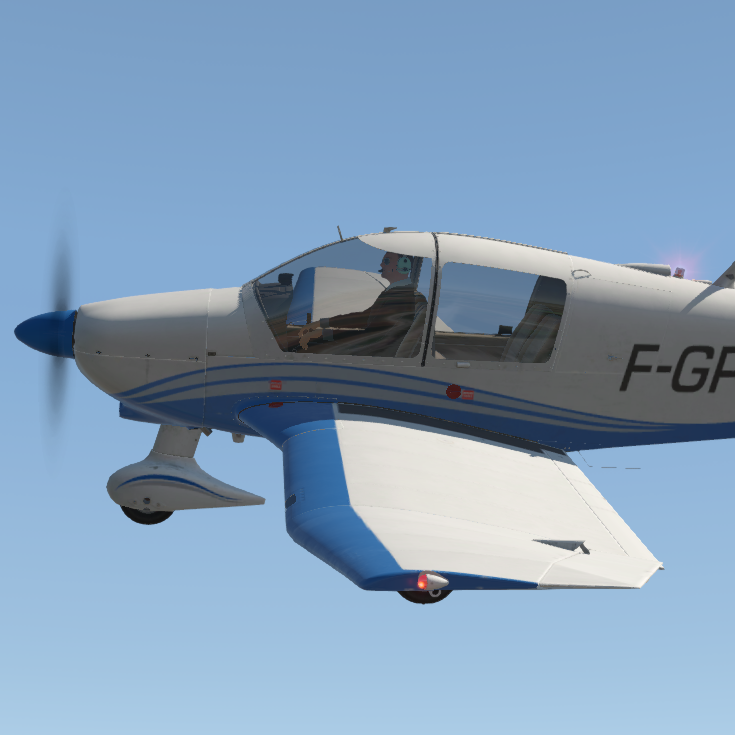
Until REP v4.5 only a few planes supported the EFM, the C172SP being among the firsts. Starting from version 4.6, REP on X-Plane 11.40+ will always enable the EFM on all the planes. This will ensure a smooth transition to X-Plane 12 once it is out as stable release, and you will still be able to enjoy the current REPs with no “service interruption”.
We also improved the flight dynamics of the older REPs based on feedback collected over the years. This includes the Carenado F33, V35, Baron and C210 among the others.
Moreover, this is a nice way to make those old (but gold) Carenados compatible with the new sim!
You can freely checkout the latest v4.6 beta following the instructions in this FAQ: https://www.simcoders.com/faqs/how-to-switch-to-rep-beta-version/
REP for Carenado Piper Navajo Preview
We’re also working on REP for the Piper Navajo as stated months ago on the X-Plane.org forum. The package is in the making and it’s looking good. Of course, it will be compatible with X-Plane 11 as well as 12!
The Navajo will feature all the usual REP improvements and a couple of powerful Lycoming TSIO-540-A2C that surely need to be taken care of the usual REP way.
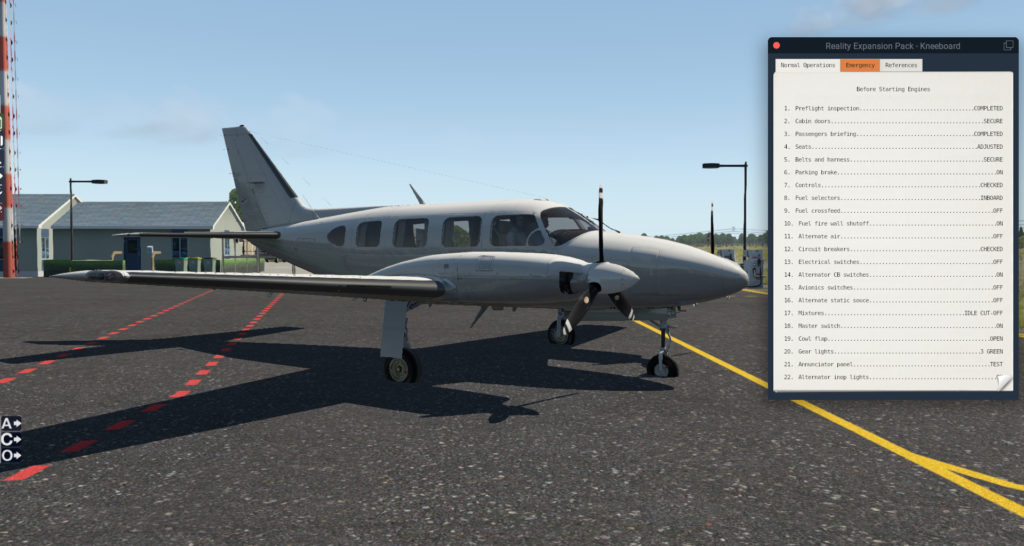
Related Posts
- Public Beta: REP v4.4.3b4
- Public Beta: REP v4.5.0b1
- Public Beta: REP v4.3.0b2
- ← SimCoders and Flight Sim Coach together to improve simulator based training
- Update: Reality Expansion Pack v4.6.0 →
X-Plane 11.50b11 Now Available
X-Plane 11.50b11 is now available. Steam users, remember you can access this version by opting into the “ Unstable Pre-Release beta ” version. We’ll make beta 11 the standard Steam public beta version once we have a newer beta.
Release note highlights include:
- New UI option: anisotropic filtering
- New Plane Maker option: always use Experimental Flight Model
- Fixed hang on load
- Shadow & crash fixes
View the full release notes here .
Enabling the Experimental Flight Model in Plane Maker
The experimental flight model has proven to be quite stable since it was released in X-Plane 11.40, so authors can now set up their aircraft to use it by default.
The new check box is found in the Author screen in Plane Maker. When it is checked, the aircraft will always get the 11.40 experimental flight model, no matter what the user pref for flight model is in the X-Plane UI. You should use this option if you like how your aircraft performs with it enabled.
When the new check box is off (which it will be by default), the user pref decides what happens, just like 11.40. Aircraft creators should pick this if they target the older flight model. Note there’s no way to force the experimental flight model off.
About Jennifer Roberts
153 comments on “ x-plane 11.50b11 now available ”.
Wow. A EFM per plane option. That’s really good news. Love it!
Yes. Definitely awesome! alot of planes are developed on EFM but i cant leave the option on because im worried i’ll forget (using a plane that doesnt use it) and find out while in the air. Its was a shame Austin was putting all that work in and it wasnt getting full usage.
Wait, I am a bit confused – so now with beta 11 – do I turn EFM check box on?
With the new build its possible for devs to decide, you don’t need to change the setting. Most commercial available aircrafts use the normal flight modell. There are some aircrafts like Thranda Porter PC6 that need the new EFM. In future the aircrafts builder can switch ist without forcing users to change xp setting.
The plane authors can make X-plane use it “pr default”, regardless of whether You have it turned on or off. -And I guess that You will be able to turn the “default” EFM off, if You open the plane in planemaker, if You want to….
Ground shadows still do not appear inside the aircraft when they do appear outside the aircraft when both are observed at the same location while flying. I don’t know if this “shadow bug fix” was meant to address this or not. I have filed a bug report on this issue before. Apparently the interior view shadow range limit is really tiny compared to the exterior view shadow range limit. The interior shadow range limits can be adjusted higher with a Lua script, but that’s a hack.
I can’t reproduce this any longer in beta 11 in the default C172 at KBOS, so if you still see this please reopen your email thread with specific details. Note that the radius of shadows drawn has been reduced in 11.50 and this could be affecting your impression of it.
Jennifer, the issue can be verified in beta 11 easily using dataref editor. The art controls dataref “shadow/csm/far_limit_exterior” is set to 500 meters, whereas the dataref “shadow/csm/far_limit_interior” is set only to 250 meters. What this means is if I go to the exterior view, I get shadows to 500 meters, but if I go back in the aircraft for the interior view, I get shadows to only 250 meters. I use a FlyWithLua script to set “sim/private/controls/shadow/csm/far_limit_interior” to 500, which makes ground shadows in-cockpit the same as ground shadows outside the cockpit. I can file another bug report if you want, but that’s the gist.
Jennifer, I have replied to your email with a detailed description similar to my above post, with perhaps a little more precise language. Thanks!
I had very nice flights in “b11”. Excellent job, congratulations !!
Hello there,
I really appreciate your effort on vulcan! To get so much support for a product already payed off can not be taken for granted.
I just want to share a little idea, off-topic:
When clicking on the customize-button of a specific aircraft (“Flight Configuration”) there is this checkbox for “start with engines running”. This applies however for all other aircrafts too and is in fact a global setting! So it does not make much sense to have this checkbox inside the aircraft customization. Instead the checkbox should be placed next to “show extra aircraft for old versions” (or apply only for the specific aircraft).
On the other hand: What should be moved to the aircraft customization screen imho is the option “EFM on/off”.
I wish the option to “start with engines running” STAYED in the settings for individual aircraft, but that you could set it differently for different planes, rather than it affecting all aircraft. In other words, most general aviation aircraft I enjoy going through the manual start up routine, but airliners or planes that I am not familiar with the start-up sequence I prefer to have them already running when I begin.
Your solution makes sense as long as the setting really is a global setting, as it currently is.
Actually I think all aircraft should start with engines off (if on the ground). Thre should be two options (if possible): 1) Just trun on engines and all the stuff that would be on up to now) 2) Exceute the startup procedure (like AI pilot tries to do)
The first option is for the impatient, while the second is for those who want to learn to handle an aircraft (before actually trying themselves step-by-step)
When entering a scenario in-flight, all systems should be on, of course.
I see that the VR loading cube has still not been fixed as well as the issue of X-Plane hanging when trying to exit after using VR. Maybe someday……… 🙁
I’m still able to crash it by panning around in Shift-4 view. Beta11, steam, auto crash report submitted.
I have this exact same problem in build 10 and 11. Although It won’t open the auto crash reporter after hanging so I can’t submit it.
Same here, crashes in shift-4, no crash raport
On Mac, you still need to restart before x-plane works.
Good job!..
very smooth flight on take off / landing, hitting solid 45FPS in VR with OVR tweek high alt was ok until I was at FL340 over EHAM. lost about 15 fps but came back once out of the way, so that was the only stop I had a large loss of FPS
what killed it was the clouds, its downloading weather using the defult weather engine that’s with XP, sadly when there are a lot of clouds about it becomes a stutter fest.. the closer I get to them the more intense the stutters get, it feels like very small micro pauses … no tweeks other than OVR and all stock scenery/textures.
i7 9700k 32G 3600MHZ 1080ti sc2
I absolutely vote for more rendering controls regarding clouds (until clouds really render fast).
the shader pipeline error is fixed. I can load some old planes.
I had a little fly with the new b11, thanks to devs. I can turn with vulkan now since the update !!! Many thanks, it’s so smooth!!!
Getting terrible performance in beta 10 and 11. Panning around in free camera the fps is very unstable. Noticeably worse when in a high detailed area. Beta 9 I had great performance. I’m getting better performance in 11.41 than I do in Vulkan. I thought Vulkan was supposed to gives us better performance? Why was Beta 9 so good with performance and beta 10 and 11 aren’t?
File a bug please.
I am getting an identical performance starting B10 and B11. In the areas where there is a lot to render- when the view is changed quickly-FPS drops to sub 20 fps; and then recovers within 1 to 10 seconds back to 50/60 FPS. Also, in OpenGL 11.50, I get half the performance of 11.41.
Will file a bug. Thank you, Dan
Chris, I had the complete opposite. I had a lot of judder with b9 and b10 was smooth as silk. B11 seems great so far.
Not sure why we see different results. That said I have EGNM by Orbx which has areas of the airport which cause the frame rate to tank. I suspect there’s some bug or excessive geometry being used by Orbx in that airport.
Everywhere else things are great.
Maybe it’s worth me pointing out I use nvidia driver 442.50.
The same problem. Beta 9 was great for me. Stable, fast, without stuttering and worked with 3rd-party addons (planes or sceneries). I am on macOS Catalina with eGPU RX5700XT.
Unfortunately, beta 10 is very unstable, it always crashes when I use a third-party aircraft or a third-party scenery. I can only run beta 10 with the default Cessna and default scenery, however XPRealistic and X-Camera plugins work perfectly even in beta 10. I have FPS playable in beta 10 (27-80 FPS), but the stuttering and crashing scares me.
I hope it will be fixed because I paid thousands of dollars for more planes and sceneries.
Version 11.41 is not usable for me, because with RX5700XT the FPS in OpenGL mode are unplayable (6-8 FPS).
Same here, beta 9 was more fps friendly, in beta 10/11 stuttering is back in the sim…..
Chris, I totally agree with you, Beta 9 was much much better with performance for me that Beta 10 & 11…..Im having so many stutters when panning and no where near the smoothness. Beta 9 was awesome for me. I should have left it at Beta 9, or at least backed it up 🙁 Im going back to 11.41 Open GL
Thanks much for getting this out, I had given up on beta 10, beta 11 so far so good, just can’t set objects to max, runs great on my Mac SE 🙂
I really can’t believe that all these people are seeing improvements. I am waiting for an improvement for more than 3 years and I still can’t even fly this game. I started to hate this X-Plane and the the way your team ignoring my comments, mails and tickets. I am spent more than 3 years supporting you to improve this thing and you really don’t care about Mac users. My iMac is the latest i7 8GB VRam, 40G Ram and I am playing this game with moooooost minimal settings. I still get 9FPS near the cloud. Yes I have 70FPS on ground but I am not playing car racing game, it’s a flight simulator which most of time I will be near cloud, and yes I did fresh install, I also replaced my iMac with new one, and yes I have no single plugin installed. Everyday I get excited and open your blog to see if there is any update then I get disappointed because I still have the same problem and you don’t care. Pleeease respect my comments and my effort to report you bugs and tell me if you are caring about this problem or I should uninstall and forget X-Plane.
I checked with support – you appear to have filed one bug against beta four and have never contacted our support team, at least since we started using HelpScout.
Your problem is pretty simple – you have too much fill stuff turned on for your iMac’s medium-power GPU, and the GPU is bogging down. This is not going to be made better by 11.50 – it’s not something Metal/Vulkan can address, nor is it part of this particular situation. Adjust your settings to get by with what your hardware can do.
We do realize that the clouds are pigs – we’re working now on something different, but it’s not going to be part of 11.50.
If you need help with X-Plane, please contact support. You filed a bug, and we don’t reply to all bug reports – heck we don’t respond to most bug reports; if we did, we’d never have time to fix the bugs. Please don’t use the blog comment section to rant.
You mention that you are working on something new relating to clouds, so I am hopeful of improvements to X-Plane’s weather system.
The greatest issue I have with the weather system is the need to redraw the weather for an entire scene when the data is updated. It’s like somebody switches the clouds off and back on again. It’s not only immersion breaking but can also cause significant problems while in flight (where weather conditions can drastically change, twice, in just a few seconds.)
Will this be improved so that changes are gradually phased in/out rather than this redraw? It would make a world of difference to the sim if it were.
Thanks, Craig
The solution would be some kind of “interpolation” I guess. Or, while in-flight, don’t change the local weather, but only the weather further away, so you gardually fly into the new weather (so to say).
Right – we consider dynamic change of the weather to be a must-have for a next-gen system.
Great news Ben!
Weather is a big one for me, so with what you’ve said I’m really excited for the future.
So, xplane 11 is finished?
Xplane 11 is Good. Isnt time for xplane 12 yet. Please dont forget xplane 11
It sounds like you are confusing Laminar with x-plane.org. Easy mistake to make
Laminar are great, decent people.
Xplane.org is pretty much the exact opposite, and almost going out of their way to give Laminar a bad name.
They are completely separate entities and share nothing in common afaik.
Agreed, Laminar should do something about it as X-Plane.org is really affecting their reputation, and it should not.
X-Plane.CRG GREAT X-Plane.ORG … well, I prefer not to say.
Yes, i see this confusion many times and ppl saying the x-plane store because they think the org is the official store.
Why is x-plane.org the exact opposite?
Mods telling people to go use FSX, banning developers for complaining the store is selling assets they made, selling them anyway, no demos and no refunds for shoddy products, and half the time someone reports a bug in the beta forum they get told to stop beta testing.
Then Laminar wonder why they haven’t heard about well known bugs that have existed for years and why users like Ahmed are complaining they have spent years being ignored and abused when all Laminar have seen is one bug report.
And thats just the appetiser.
All of the above is the exact opposite of anything I have ever seen from Laminar/X-Plane proper.
That sounds atrocious. I wonder why Laminar Research is not hosting a forum and providing a marketplace for payware and freeware content.
You have a weak mac computer. Please upgrade to a high end pc. Cloud performance will be improved in a later version of X-plane. This forum is not about your feelings, but I hope you will feel better soon.
Ahmad Just checking to see if you run your laptop on AC power or on Battery? My Dell crawls when on battery. But when im on AC power X-Plane runs extremely well. I apologize if this is potentially insulting as i don’t know your level of knowledge. Oh and temperature control is very important as well. I use a laptop cooler.
Errrrh, I’m on a 2017 iMac i7, 8GB GPU and 64GB RAM and on Beta11 I get a solid 90FPS at ORBX Sumburgh with ORBX North England, and that’s with most settings on Medium-High?
Some of the LR guys develop on Macs, so I think it’s somewhat disingenuous to state they don’t care about Mac users, because I think its actually the opposite my good man 🙂
I found a weird issue (but it might just be me) although it starts from a weirdness that has always been there.
I am used to every version of x-plane 11 doing this: when I right click to pan and hold the button , then move my mouse (the arrow) off the x-plane window. If i release the right click while i am still outside of x-plane, when i return the mouse arrow to x-plane, x-plane will still be in pan mode . This has made for some hair raising times when looking around while turning to final .. mostly when i first bought x-plane but im kind of used to it now (not saying I am fond of the behavior, but it is what it is) and its avoidable.
With b11, I am having this behavior without going outside of the window. Meaning when I right click to pan around , and move the mouse , its as if x-plane cant see the mouse for a second and goes into click free pan mode. I have to right click and release to get out of that mode.. seems like the mouse arrow is skipping when this happens (my mouse is not doing that in any other of my applications and didnt in b10 either) ..
This is only my first flight in b11 but since it started happening right away from c&d ( but with the same plane etc that was not exhibiting this behavior in b10) I thought i wouldd mention it.
I am almost at top of climb and everything looks good
I think you can “lock” the right-click mouse view by clicking twice fast. This will incur what you are describing.
Yeah.. It happens my mouse just happened to start dying between versions. The right button is registering erroneous double clicks. Ignore my message. b11 is fine.
Another good upgrade from the previous beta. Definitely more stable it seems. The jumping from preset camera position to camera position is WAY smoother and instantaneous and the FPS drop is way more stable. It seems youve really gotten the paging and VRAM in much more control.
Dare I say it, Im trying for a crash so you guys can feed on the info! Will test Aniso next time from x4 to x8 and see the FPS impact. The “shimmering” artifact is very very noticeable at x4
Solid improvement
Now that the Vulkan is relatively stable. Can you tell me (only yes or no) if in the near future you will try to improve the visual aspect of Xplane 11?
I’m talking about a new cloud engine or some improvement in rendering…
You have to disguise your question for “weather” and “seasons” a bit better to lure Ben into your trap 🙂
Yes. After 11.50 my next tasks are all improving how things look (as opposed to 11.50 which improves how the code draws them, hopefully faster without stutters). I am already doing some work on that now.
O god!! I offer myself already for the private beta hahaha
Ben, I don’t know if you are aware, but B11 has some stutters back, but it has been very stable besides that. If you fine tune it to remove the stutters, maybe B12 can be the last Beta.
That’s great. I hope it’s for xplane 11. This simulator can give you so much more.
The known addon issues section of the release notes should be updated. XPRealistic is fully 11.50 compatible and so it BetterPushback.
StopZoomingDammit does not work with 11.50 so it should be added or even better implemented in the core sim
Delighted to report that my load time is back down at 1:52 (second and subsequent loads) FANTASTIC!! in B10 it had gone out to over 7 minutes and didn’t really change that much on second and subsequent loads.
Great job LR.
FYI My Rig is an all pcie4 setup. MSI X570 pro motherboard, 16Gb ram, Radion 5700 XT GPU, Ryzen 3600X CPU
First of all thanks for this great effort.
I’m facing right know some problems everytime i approach to an airport, i did posted on forums but nobody has answered yet.
I already sent almost 3 diagnosis files but nobody has contacted me yet.
https://forums.x-plane.org/index.php?/forums/topic/216793-weird-behavior-on-final-1150-b10/&tab=comments#comment-1952422
update from last post,
Loading is fixed and the sim hasn’t crashed once…FPS are very high, smooth as silk in VR AND stutter free in the Zibo 737 YESSS!! … only place I get stutters now are flying directly into clouds or close to them however the better clouds lua fixed that.. would it be possible for you to mirror the fix that’s currently out? I understand the clouds do not form part of the vulkan update but with this lau I am able to see the full potential of Valkan.. without it the update is hinderd.
shadows are still a little twitchy in the clouds and ground but far better than B9 and 10, this has go to be the first Vulkan update that actually shows what x-plane can do.
Please release xplane 11 on Geforce now. We could play then on low quality pcs or on laptops in the hotels if theres good wifi. Please :)))
Many many thanks for the AF Slider. This is game changer for me. B11 runs very good on my system. The visuals, especially at night, are fantastic.
But, are there any plans to work on Anti Aliasing settings, to get rid of the shimmering on taxi lines and buildings and so on? SSAA + FXAA don´t elimate this enough.
Thanks Andreas
At some point we will look at additional AA tech – I think the main complaint here is that: – HW MSAA isn’t available in HDR mode and – 4x/8x SSAA is really expensive GPU-wise relative to the improvement. I have some ideas for improvement, but there are major changes to the graphics pipeline in the works, and we have to evaluate AA once things have settled down.
I think MSAA has a significant impact on CPU times in VR. I always have headroom to apply Steam SS, however, MSAA will reliably reduce my framerate signifcantly, no matter how much headroom I have in VR.
MSAA should have no affect on CPU time, only GPU time.
Great job on b11! Distant mountains now look great. FPS is good, and no sim crashes yet, except for the regeneration of icons, where my sim still crashes. Even with default installation and default 172. No addons. I did file a bug report.
Ben could you tell me when do you plan to implement sounds attached to the scenery objects? The X-Plane World Simulator with only airplane sounds it’s not enough
I cannot…because we don’t pre-announce times for new features. I can say that this is something that is in the works, and I have some working code for it.
Note that the feature has more steps than it sounds…sounds attached to _which_ OBJs? Our first target is plugin instanced objects, so plugins can put particles, objects and sound into the sim together in one simple API. _Scenery_ objects with DSFs are the most difficult case because they aren’t live actors in the sim.
This sounds great Ben. BetterPushback sounds get lost in my system, insofar as the volume of the Tug is so very loud in comparison to other soundscape elements. There are no controls available to balance this element.
So I’m looking to add a 3rd monitor to my Mac setup. If I add an egpu to drive the new monitor, will XP (beta 11) be able to use the metal processing power of both GPUs? Or will it only use the main GPU?
We will not use both – we will only use one or the other ,based on the app settings.
Just a heads up that in the b11 version OpenSceneryX is causing a “Pipeline must not be nullptr” error, I have submitted the crash reports already and tracked it down as far as the above scenery library causing the issue.
Outside of that the few flights ive tried have worked well, missing a lot of my scenery though as all of the australia scenery packs I use require opensceneryx lol
I think we’ll have this fixed in b12.
Is there a limit to the number of objects in custom scenery?
X-Plane crashes with certain scenery if world objects is set higher than medium…
There’s a bug in b11 on OS X where we crash if the forest density gets too high – will be fixed in b12.
Thanks, I‘m glad it‘s a known issue which will be fixed:-)
Wonder if this is why the Sim crashed in a flight from KBOS to KSTL on two separate occasions recently? (Both after about 1hr 45 min.) Have been an XPlaner since XPlane 8, but haven’t had this problem before. Have temporarily reverted to 11.41 so that I can continue while beta 11 is unpredictable. Have a 27″ Mac (2017) with 24 GB and 8 GB graphics.
How far are we in the crawl/walk/run cycle? Or better said, how far is a release candidate? Seems like most of the known bugs have been fixed
I think we’re close to run, ish? At this point we’re happy with VRAM allocation – or at least, it’s good enough…we could spend years tuning and tuning it, but most of the really brain damaged stuff seems to be fixed. Sidney has two sources of stutters fixed for b12, and we’ll see where we’re at.
Thanks for the Anisotropic filter slider!
Now if we can convince you guys to give us an “advanced” menu that gives separate sliders 1-5’ish scale for all the separate goodies accessed by hacking the settings.txt file, we’ll be in business! 😉
No no that’s not how it works. If you ask for an advanced menu too many times I _take away_ anisotropic filtering. 😉
Define “too many times” lol 😀
Are there plans for improving the loading sequence of the game when in VR? Something like Elite Dangerous, for example.
I am concerned. Since b10 vulcan has become unplayable for me in VR, same in b11, huge performance drop in comparision to b9 and earlier versions :-/ I turned off the plugins, deleted the contents of schader cache and prefs, without any improvement. looks like performance has been sacrificed for stability. Great disappointment. Is this a known problem and will it be corrected? Until now, I could play almost all airplanes in almost any conditions. Now only the least demanding with basic scenery, clean sky, outside the cities :-/ My hardware: gtx1080ti, i58600k, 32GB RAM, VR – Samsung Odyssey.
It’s the opposite for me. I’m using orthos, xEurope, UltraWeatherXP, Active Sky, XPRealistic and some Lua scripts on an Ryzen 3700x, 1080ti, 32GB Ram system and hat the best VR Flights without any stuttering and great immersion even on high object counts. The only problem i have sometimes is, that x-plane is crashing on start and i have to reenable Vulkan.
In graphics options there is a note that at least Win8 is required for Vulkan. Is Win8 officially supported for Vulkan or is it unofficial? In the announcement of Beta 1 only Win10 was mentioned.
Ben, Why does the VR resolution affect the CPU response time? I have a HP reverb which runs at 2160×2160 on default settings. I have to lower the resolution to reduce the cpu response time in order to reduce the stutters, which completely defeats the point of having a high resolution headset. I don’t understand why the Cpu is involved in this process? I may be wrong but It appears to me that Xplane is still very cpu intensive and is bottlenecking the performance of the GPU somehow. I upgraded my cpu and GPU to the maximum spec available purely to increase the performance of xp and I’m really disappointed that I still appear to be hitting a performance wall in xp. I understand that vr places huge demands on the system but I’m convinced the cpu is not giving enough work over to the GPU. If I’m wrong I’m happy to be corrected but I would appreciate your comment on this. Regards, Andy.
What makes you think the large resolution is bottlenecking the _CPU_ time?
I’m using VR FPS to analyse performance. It displays real-time information in the headset including CPU and GPU usage and response time in ms. I’ve observed that a change in headset resolution has a negative impact on the cpu response time, I don’t understand why, it makes no sense? Response time is shown in the form of a graph along with numerical real time and average display. In a low resolution setting the CPU graph is green with a cpu response time around 11ms and GPU around 2ms. At a high resolution the GPU remains at 2ms whereas the CPU increases to around 18ms and the graph changes between amber and red and results in stutters.
I have no idea why that would happen. But without a more technical explanation of _what it is measuring_ there’s not really anything I can learn from it.
FPS VR provides real time information in the headset of cpu, GPU and memory usage, response times and temperatures etc….. I’ve been unable to run xp without stutters so I’ve been using FPS VR to understand where the bottleneck is. I run xp with Orbx scenery so I need the scenery settings on on their maximum setting Otherwise the scenery looks like the result of a nuclear holocaust with missing buildings etc. I was at the end of my tether after enduring hours and hours of experimentation and testing trying to produce a smooth , usable and realistic experience and as a last resort I tried reducing the resolution of the vr headset. This produced a vast improvement in the frame rate and removed the bulk of the stutters, however, it looked absolutely awful! I repeated the exercise and paid attention to the graphs and there was no change to the cpu or GPU usage. However there was a significant change to the CPU response time when I increased the resolution, that’s all I can tell you. Running xp on maximum scenery settings at a high VR headset resolution seems for reasons that I don’t understand or can explain have a detrimental effect on the cpu response time. There appears to be a correlation between scenery complexity and headset resolution that overwhelms the performance of the cpu. Hope I’ve managed to make sense? It’s just something that I’ve discovered and therefore felt obliged to pass on my findings to the expert as I haven’t got a scobby do about programming! 🙂
2160 x 2160 ???
Pixels per eye!
I have to agree with this guy….
Seems when using the HP Reverb and world objects Max settings you do in fact hit a wall on the cpu.
My last setup i7 7700k @ 5Ghz water cooled on 4 cores 1080 ti @ 1920Mhz
I would get 13 fps… As per fpsvr GPU 42ms CPU 80ms but cores run most times 38%
My New System
i7 10700k @ 5.5Ghz water cooled on 8 cores Radeon 7 16GB @ 2300Mhz water cooled
Now running the same Orbx true earth Florida as my old system I get the same 13 fps with my new system.
As per fpsvr GPU 43ms CPU 78ms Now once you drop world objects one notch to the left and FPS increase to 44 fps
As per fpsvr GPU 42ms CPU 44ms = 44 fps
No matter what cpu you are running world objects high will cripple any cpu you use. The cpu is always the bottle neck…
Also running the HP Reverb in Vulcan or OpenGL with high settings makes no difference. You really see NO improvement running Vulcan.
X Plane seems to only shine in Vulcan when you are running reduced graphics settings. Just find it hard to believe I can go from a 5 year old system to the new system I have now that I see NO performance increase at all??
Just for giggles N grins running Half-Life Alyx on ultra
Old 7700k system 48fps New 107700k system 94fps
As you can see a very big jump in fps but in X Plane not so much
I’m in the same boat. XP11 has always been CPU bottlenecked in VR since its introduction. Vulkan should theoretically be able to multithread the draw calls which I suspect is a large factor in the existing CPU bottleneck when playing in VR, however I don’t think they are doing this in 11.50 betas, as the performance is basically the same OGL Vulkan, except texture stuttering is reduced.
Jennifer, will there be another global airport update before the public release of 11.50?
I’m looking to update some airports if there’s a chance it makes 11.50 and would be interested to hear what’s the deadline to upload them to gateway.
No, as far as I know we are not planning another Gateway export for 11.50.
after update to b11 I have “pre-built shader missing” crash! this happens in vulkan mode.. not with OpenGL. any help?
Hi, frecuently my x plane crashes and in Windows Events Viewer it says the origin of the event is Application Hang, is this relationated with the beta version (11) or maybe could it be a error of my computer?
Thank you, thank you, thank you and thank you!
While b1-b9 immediately crashed upon loading on Linux with Vulkan (crash reports submitted), now Vulkan runs beautifully and smoothly right out of the box. The FPS have gone up from OpenGL to Vulkan by incredible 42% at my favorite graphics settings. And load times have decreased from 4min45s down to 42s.
Did I say thank you already?
Have had a couple of flights in b11. Another huge leap forward now that the shaders are fixed. However I had a CTD last night mid-flight. I hadn’t changed a thing!
Still getting some weird flashing when I look in certain directions in VR. However, overall, I think you guys have done an incredible job with Vulkan. For the first time in 20 years I can now fly stutter free in VR with great detail! Thank you so much!!!!
Still Crash when panning outside after 15 to 20 min into the flight. With B10 was about 10 min then crash. Mac, i9 9900K, 4.9 mhz,64 gb, radeon 5700XT. already change the settings and doesn’t look to get influence from that. Also try a complete new installation and no add ons, same behaviour. FPS looks very good getting over 50 with high settings. no stuttering visible during the flight. bug report filled
Keep getting crashes since the early Beta releases. 11.5B11 – still reports Vulkan Device Lost Error. Have reported this on numerous occasions but it’s still very apparent. App crashed six times tonight in about 20 minutes – gave up in frustration ☹
Hello Ben et al @LR
Are strobing artifacts in the graphics (namely the haze way off at the far horizon at around 30,000 feet basically strobing on and off, theres no better way for me to describe it) an expected or previously reported issue in the beta phases?
Im getting them.
Hi, I’m having a issue where it just loads up 1 core on the cpu and the rest are largely unused.
Are there any planes to work on Ryzen cpu pefromance optimization as you know Ryzen 3 will be coming out near end of the year so it will be level playing field.Ms Flight 2020 is going to be taking advantage of more cores and will be optimizing for ryzen , its a just though thats all
I am seeing activity across all my 12 cores (cpu’s) and super fast load times. with World Objects set to Max, Reflections at setting 3
Tried to paste a screenshot oif my core activity but couldn’t. I think because of the work done by AMD with their Infinity Fabric, X-Plane by default is already optimised …. buy what do I know
Hi I frecuently have crashes on my x plane, in the Windows Event Viewer it says is an error called application hang, could it be a x plane error or a computer error?
Thank you @Team X-Plane, I have been using X-Plane for about five years now. I have stopped using 11.41 a long time ago. Having said this, I have been downloading beta after beta with increasing performance and graphics. I have what has been describe here by others as a medium level computer. My point is that I am starting to see the what others with high end PC’s (mainly Twitch and YouTube streamers) have been experiencing. My system is running smoother and smother with each update. When you announced the Vulkan project you all describe its potential and you have been right on target. There is passion on this team and it shows. I can only imagine what you could do if you had the resources of a Multi-billion dollar corporation. Keep up the great work.
I’ve been having issues with VR. I use a Rift S. 9 out of 10 times during the “Preparing World” the status led on the headset goes from white to orange and the log file shows:
0:02:03.204 E/OVR: Session display lost, becmoing a zombie.
0:02:03.263 E/VR_BRIDGE: Shutting down hardware because the VR HAL is now in a zombie state.
0:02:03.466 I/OVR: Shutting Down VR Subsystem.
So here’s what I have to do to make it work:
1. Start X-Plane with VR disabled 2. Start the new flight and let it load 3. If I see that the LED has changed to orange I just use Oculus Tray Tool to restart the oculus service and the LED then goes back to while 4. Enable VR and fly like normal
So for some reason something is happening with the oculus service requiring it to be restarted to work properly. And yes…bug report has been filed. The inital response I got back was:
“Thanks for your email. Unfortunately, the recent Oculus update has caused some issues with X-Plane. However, we have released a fix in the article below. X-Plane 11.41 and Oculus v17”
And then I explained this is not with 11.41 which is what the “fix” addressed. Hopefully this can be sorted out. While I have a workaround it’s not the most efficient way to start up a flight.
Turn off USB suspend in tray tools.. I had this problem and found out that during loading it would suspend the USB, might be because there is no loading screen yet for the VR
Thanks..I’ll look but I believe I already have that set.
Hi, I’m also using the Rift S, and everything is working fine.
The Orange led means that the Oculus Software can’t find your headset. This is not caused by X-Plane. You could try repairing the Oculus Software (Download and run Oculus Rift software from http://www.oculus.com/setup , and then select Repair)
The Oculus software has been repaired, and when that did not help I did a complete uninstall (and even removed folders, etc left behind) and did a fresh install. As I recall I do not believe I had this issue with beta 10..but if I did I know for a fact I did not have ANY issues with beta 9 and nothing had changed with my Oculus setup. And you say this is not caused by X-Plane…not sure why you assume that. X-Plane even logs some errors when this happens. So, I’m not say this is X-Plane but I’m not going to blindly assume it is not. I have a workaround so the world is not ending but we know VR is not totally clean with X-Plane…no loading screen, hangs when you try to exit X-Plane, etc.
With this new beta 11, X-Plane has started crashing for me, saying that there’s a problem with Vulkan drivers (Vulkan driver loss) . It never happened with older beta versions.
Exactly the same here as reported earlier in this thread [Vulkan driver loss]. Could the devs give us an insight into this voodoo because when X-Plane [did] work under Vulkan drivers – it was most impressive with great frame-rate. Unlike OpenGL which gave me 6-15fps max – hence using the current stable_release isn’t really very exhilarating. In addition, I’m seeing quite a few AMD RX 5700XT GPU users suffering bad experiences.
Uh…no insight here. Like, we don’t know why the device is lost. If we did, it’d be a huge win for the next beta; we’re investigating now, but we think we have a memory timing bug. But we’ve seen device loss consistently through the whole beta. We are actively investigating it now.
I can’t even depart anymore in VR. when I move 5 meters, xplane crashes with device lost error.
I was a long time FSX user and like a month ago I decided to try Xplane11. I can honestly say that it changed the simulation experience for me. But after playing a month I realized that with these settings I was getting around 20-25 FPS and my laptop was over-heating;
Visual Effects: Medium Texture Quality: Medium World Objects: Low
Then I installed some plugins to increase the FPS such as Vivid Sky, X-Visibility, and HDR v4.0. But my FPS was still the same. When I was outside the cockpit it was around 30-35 but inside the cockpit 18-25.
It was really painful for me to play the game with these settings, so I decided to try Xplane 11.50b11. I downloaded public_beta (which gives b11 in Steam Version) and I realized that I did not much gain FPS. With the same settings above I was getting around 23-27 FPS.
Then I decided to activate Vulkan but my Nvidia driver was not supporting it (Xplane gave an error). So I found the official website of the GeForce. Then I updated it to handle the Vulkan (which I was not aware that it was possible). And it worked :). Now with the
Visual Effects: HDR Texture Quality: Medium World Objects: Medium
settings I am getting around 35-40 FPS inside the cockpit and its so smooth. It was really hard for me to play Xplane before this transition.
Here all the plugins that I was download before the beta11.
BetterPushback HDR v4.0 X-Visibility Vivid Sky Airport Environment HD 2.13 Zibo 738
But before I made the transition to Xp11.5b11 I deleted BetterPushback and Lua scripts for X-Visibility and Vivid Sky.
Here are my computer specs: i5-7200U CPU @ 2.50GHz Ram:8GB
My suggestion is if you are suffering from low FPS try to update your Nvidia driver by using GeForce and then try Vulkan. However, if you have downloaded a lot of Lua-scripts etc maybe you should delete the whole game and download it again.
I did not have a chance to make a full-flight but it seems that it’s working great for me.
Thanks a lot!
I’m not near my sim, so I can’t grab the log.txt, but has anyone else noticed how dim all airports all at night? So dim, it is impossible to see the runway? This is in beta 11.
Next transition, Mac ARM ? 😀
I expect we will support ARM natively when it comes out. ARM will be our fourth (or possibly fifth) ABI change on the Mac – in this case, the tools that made the x86 and 64-bit changes fairly routine (multiple ABI targets per app) should work here too – we’ll just produce an app that’s x86_64 and ARM 64 at the same time. I don’t know what specific issues we’ll hit, but we ship ARM64 code for the iPhone now and it just works. And Apple’s modern ARM chips (e.g. in the iphone 11) are screaming fast. We’re always a little surprised how quick they are.
Are there any planes to work on Ryzen cpu pefromance optimization and getting more fps on the platform Ryzen 3 will be coming out near end of the year so it will be level playing field against Intel Ms Flight 2020 is going to be taking advantage of more cores and will be optimizing for ryzen , its a just though thats all
Hello, I installed the beta 11, I have a drop in fps when I rotate the view of the plane both outside and inside e.g. step from 80fps even up to 25 fps. Second problem as soon as I took off from Orio al Serio Italy, the simulator crashed, I deactivated Vulkan and reactivated open-gl Non Crasha. So there is a bug. I await new clouds and a new global scenario.
I beg you / Austin not to switch to a subscription model for X-Plane 12. It would be the only one reson for me to stop my flight simulation career. It would be very sad for me and my kids. I can’t wait to see X-Plane 12 in place and will also in future give my (also financial) support to this ecosystem of X-Plane products. But a subscription model is against an open minded, community oriented approach and filosophy I soo much like and respect in X-Plane. Please, please do not go this way. kind regards Stefano
I am afraid colleague that things are happening through “the cloud”. I already warned that all of my colleagues and I would be abandoning Laminar Research while doing so … And now they’ve gone from not just using the GPU to overlooking it. Vulkan has too much microstuttering
i7 4790K 4.4 GHz/RAM: 24 MB, 1.600, CL7/GTX 1070 OC 8GB GDR5/Seasonic 1000W Titanium/ X Plane 11.50 beta 11 in ssd Samsung 860 Pro 1TB. Full very well refrigerated. Ben: You’ve fixed the cloud shadows a lot, okay. But the sun reflected in the water and the water itself are sad … I insist with the constant micro stutter with Vulkan
Ideally, if the Experimental Flight model is not selected by the aircraft author in Plane Maker, in the GUI of XP, it could be made in a way a user enables it per aircraft and not globally.
Some aircraft are more adapted to the Experimental Flight model while others aren’t and if the authors do not make it by default, users could enable it for the aircraft that are adapted to it and it will remain enabled if the specific aircraft if selected later.
For now, users could forget to enable or disable it if they change the aircraft.
I do forget to switch it back when I switch planes.
Getting some trouble with the latest nvidia driver (451.48) which supports Vulkan 1.2. I’ve had some crashes with b11 and driver 546.11 but now CTD on nvidea driver 451.48 is really more common 🙁
Same problem here, I do not know what to do, I can not even open a scenery and it crashes.
Since I installed Nvidia driver 451.48, X-Plane still has a high FPS rate, but all animations seem to “oscillate”: Vehicles on ground accelerate and descelerate instead of moving at constant speed. This effect also applies to flying through clouds, turning the view in the cockpit with the mouse or TrackIR, panning around outside the a/c…
I am not certain if this is a bug because that all was not a problem with the former driver version. All was smooth before.
Regards, Marc Westhofen
——————————- If it helps – these are my specs: CPU: Intel Core i7 9800X (OC 8x 4.8GHz) // CPU Cooling: NZXT KRAKEN X72 // Main Board: ASUS TUF X299 MARK 1 // Graphics Card: GeForce RTX 2080 Ti ROG STRIX O11G // RAM: 32GB (G.Skill Trident Z RGB Series, DDR4-3000, CL 15, quad channel) // Hard Drive: Samsung 970 EVO NVMe SSD 1TB, PCIe 3.0 (M.2) // Optical Drive: LG BH16NS55 // Power Supply: Corsair HX850 High Performance // Head Tracker: Track IR 5 // Mouse: Logitech G203 // Joystick: Thrustmaster T.Flight Hotas Stick X // Keyboard: Logitech G815 (tactile) // Monitor: LG 27UL850-W (3840×2160) + LG FLATRON IPS235 (1920×1080) // OS: Windows 10 Pro 64bit // SIM: X-Plane 11
Is there any known issue with Default Global Scenery under Metal? I installed clean and launched default plane and scenery for VHHH (Hong Kong), XP crashes to the desktop. There’s no extra add-ons, plugins, scenery.
This happens only when Number of World Object is set Maximum.
Unfortunately beta 11 is a step backwards for me. I had noted major performance improvements in previous betas but since b11 I get weird input lag when looking around the cockpit. Frame rates also appear to have decreased by about 40-50%.
Intel 9700k, RTX 2080ti 11GB GDDR6, 32Gb RAM, 1TB 970 Evo Pro SSD
Hi, performance as “External Visual” under Ubuntu 20.04 is very good. But only if not moving… Although the fps itself is hight (30 to 40) there is a ~4Hz stutter when vsync is active. Without vsync there is still noticable stutter and lag between the master (>120fps) and the External Visuals (~40fps). BTW: what is the best setting for “Transmissions per Second” on the master? Is it possible to disable the position extrapolation for External Visuals, as I think most of the lag is introduced by that.
Cheers HellG
Are there any plane to work on Ryzen cpu peformance optimization for ryzen c and getting more and smoother fps on the platform Ryzen 3 will be coming out near end of the year so it will be level playing field against Intel Ms Flight 2020 is going to be taking advantage of more cores and will be optimizing for ryzen , its a just though thats all
The VR device loss bug is back
b12 has just broken my install, issues with shaders
=====legacy_flat===== 0(28) : error C7600: no value specified for layout qualifier ‘off’ 0(29) : error C7600: no value specified for layout qualifier ‘off’ 0(30) : error C7600: no value specified for layout qualifier ‘off’ 0(31) : error C7600: no value specified for layout qualifier ‘off2’ 0(32) : error C7600: no value specified for layout qualifier ‘off6’ 0(33) : error C7600: no value specified for layout qualifier ‘off2’ 0(34) : error C7600: no value specified for layout qualifier ‘off00’
=====legacy_flat===== 0(18) : error C7600: no value specified for layout qualifier ‘off4’
0:00:00.000 E/SYS: +——————————————————————————- 0:00:00.000 E/SYS: | There was a problem processing a GLSL pixel shader. 0:00:00.000 E/SYS: | You may need to rerun the installer or update your graphics drivers. 0:00:00.000 E/SYS: | legacy_flat_34.glsl 0:00:00.000 E/SYS: | legacy_flat_35.glsl 0:00:00.000 E/SYS: | (gfx_ogl_shader_module.cpp:414) 0:00:00.000 E/SYS: +——————————————————————————- –=={This application has crashed!}==–
This worked fine before the update this evening, I have a 1080 GTX and the latest version of the nvidia drivers
Oh crap. This is us. B12 is borked. You can re-run the updater and it’ll take you back to b11.
Thanks Ben, working again now
B12 landed via steam on my setup. I have to say in my case it runs silky smooth. Literally max settings (with exception of reflections), 50fps whilst flying over central London with Orbx scenery. Not a single judder. Clearly some issues for to iron out overall, but you guys are working miracles with the progress being made here -thank you Ben et al.
Yeah – then it unlanded…it was doing good except that GL didn’t work _at all_…this was a weird one, our build system cut the wrong shaders. First time we’ve had a build die cuz the robots built the wrong thing, ever.
Anyway, in the 10 seconds it was up we also discovered a missing pipeline when textures are missing so we’ll fix both of those and recut it for Monday.
What about the MD82 default sounds being updated to FMOD? Laminar did show this and i never got the update. Is it even planned to update the MD82 sounds to FMOD?
It hasn’t been released yet but it is a thing.
Hi Ben, does b12 address the stuttering issue introduced with NVIDIA driver v451.48? I didn’t see anything in the patch notes regarding this issue.
Prrrrrobably not? B12 was cut before we heard about 451.48 stuttering, which we haven’t even analyzed yet.
But b12 addressed too much AGP paging of OBJs, which was a source of stuttering in b11. So it’s possible that the two stutters interact.
All I can say Ben to all the team, thank you for all your hard work, I think you are making a lot of people happy. B11 works fine on my machine.
Comments are closed.

Cessna 172 Enhanced Flight Models
Frequently asked questions (faq).
Q: Where can I buy it?
A: You can buy it at the X-plane.org store .
Q: What C-172 models are included?
A: Three versions are included: C-172S, C-172R, and C-172M.
Performance is precise and accurate for each model, and they
all share the same graphics, system, and sound models.
Q: Why use the experimental flight model? Isn’t that ‘unstable’ or unreliable?
A: The experimental flight model is already considered stable and reliable by the X-plane developer. The improvements it brings enables much better realism and accuracy. The current experimental flight model will become the standard model in a future version of X-plane (Some version after 11.50).
Q: Can I use the ‘normal’ flight model instead?
A: Yes, you can. There will be a small loss is realism however, such as airspeeds in error by a few knots, stall speeds too low, and over-responsive handling.
Q: Do I need to install any additional software or Windows components for the plugins to work?
A: No, as no additional plugin is used! The X-plane flight dynamics are leveraged to their full capability, so no plug-in over-rides or faking is required!
Q: How difficult is the installation? Do I need to rename or modify files?
A: It is very simple, extract the contents of the downloaded file into the existing C-172 folder and you’re done!
Q: It does not work, I get an error about a 'damaged sound bank'!
A: You did not install it correctly. Please see the manual for clear detail on correct installation.
Q: Can I add this to a different C-172 model from a different developer?
A: No, this expansion pack is compatible only with the stock C-172 that comes with X-plane.
Q: I need an accurate C-172 to help with my flight training. Is this a good choice?
A: Yes, this C-172 model is the most accurate simulation I know of. And I have flown many hours in various REAL C-172s myself!
Q: I cannot see any difference between this model and the original! What went wrong?
A: This expansion adds two more variants of the C-172 and enhances the existing C-172 flight dynamics. However there are no changes to graphics, sounds, or systems as these are already very good in the stock model.
Q: Older Cessnas like the C-172M are actually a bit different in the cockpit, for example the flap position indicator. Are these differences modelled?
A: No, the cockpit graphics are the same as the stock C-172SP, but the flight dynamics match the C-172M precisely. The C-172M flaps are simulated as ‘infinitely adjustable’.
Q: How can I used the carb heat in the C-172M?
A: Use the following key commands, or you can assign joystick buttons. F9 = carb heat off. F10 = carb heat on. F11 = carb heat toggle.
Q: How do I find the Enhanced version in X-plane?
A: The aircraft icon in the X-plane menu will show ‘EFM’ in the lower-left corner. Simply choose which model (S, R, or M) and fly.
Q: Where is my serial number to activate this product?
A: No serial key or manual activation is necessary. Simply install and fly!
Q: Will this add-on work in X-plane 10?
A: No, this add-on works in X-plane 11 only, and X-plane must be updated to 11.40 or later.
Q: Is this add-on Vulkan (X-plane 11.50+) compatible?
A: Yes, but it makes no difference if you use Vulkan or OpenGL.
Q: Is this compatible with FSX or MSFS 2020?
A: Only the Linux native versions. ;-)


- Remember me Not recommended on shared computers
Forgot your password?
- 737-300 Aircraft Systems and Operation

11.50 Final and Experimental Flight Model?
By Torbinator September 10, 2020 in 737-300 Aircraft Systems and Operation
- Reply to this topic
- Start new topic
Recommended Posts
What is the protocol for the experimental flight model with IXEG v1.33 and 11.50? Is there a setting in plane maker to apply the Experimental flight model with this particular airplane only in 11.50 final?
Do I remember correctly that Laminar was going to give developers/users this option in Plane Maker?
One of things I find challenging, as simple as it may sound, is too remember to turn on and off the experimental flight model when switching between airplanes. Given that the simulator can take several minutes to start up, it can annoying when you have limited time after work/dinner to squeeze in a flight and you realize the experimental flight model was left on or off incorrectly.
It would be nice if this would happen automatically when switching between airplanes, which I thought I vaguely remembered reading would occur if it was specified in a future version Plane Maker.
Link to comment
Share on other sites.

Hi Torbinator,
you are correct - there will be a setting in planemaker to "always force experimental flight model on".
We will incorporate that in our next update - but I think you can just set the option in the .acf file yourself right now so it *should* always work. I haven´t tested this yet, but will soon.
Cheers, Jan

- 2 months later...
Nice .. meanwhile, in the acf file just change this:
P acf/_use_1140_fm 0
P acf/_use_1140_fm 1
How do you then know if the EFM is on though? Does the 733 show a warning or some such thing? Having that line in the acf file does not (predictably) set the EFM checkbox in settings to 'On'.
I don´t think you can really tell - there is no feedback to the user at all.
The checkbox in the GUI is not influenced by the setting in planemaker - it will simply stay the way the user has it (on or off). The setting in planemaker will override the setting in the GUI.
That's what I assumed. The Zibo 738 does show a big warning in the EFB if EFM is on , so I wasn't sure..
Could you kindly just remind me which functions in the IXEG 733 will not work properly with EFM off? I seem to remember seeing that described somewhere in the past, but cannot locate it now.
There is a different trim setting during takeoff, so setting the "correct" trim will lead to higher-than usual yoke forces needed (due to different downwash model) and the drag is different (due to the different lift/drag of the fuselage during high AOA flight).
Both of these things are not super obvious, but you will notice, especially if you are used to flying "by the numbers".
OK, nothing too catastrophic then. Thanks.
Join the conversation
You can post now and register later. If you have an account, sign in now to post with your account.

× Pasted as rich text. Paste as plain text instead
Only 75 emoji are allowed.
× Your link has been automatically embedded. Display as a link instead
× Your previous content has been restored. Clear editor
× You cannot paste images directly. Upload or insert images from URL.
- Submit Reply
Recently Browsing 0 members
- No registered users viewing this page.
- Existing user? Sign In
- X-Pilot Home
- Add-On Store
- Latest X-Plane & Community News
- Online Users
- All Activity
- My Activity Streams
- Unread Content
- Content I Started
- Leaderboard
- Create New...

Suggested Searches
- Climate Change
- Expedition 64
- Mars perseverance
- SpaceX Crew-2
- International Space Station
- View All Topics A-Z
Humans in Space
Earth & climate, the solar system, the universe.
- Aeronautics
Learning Resources
News & events.
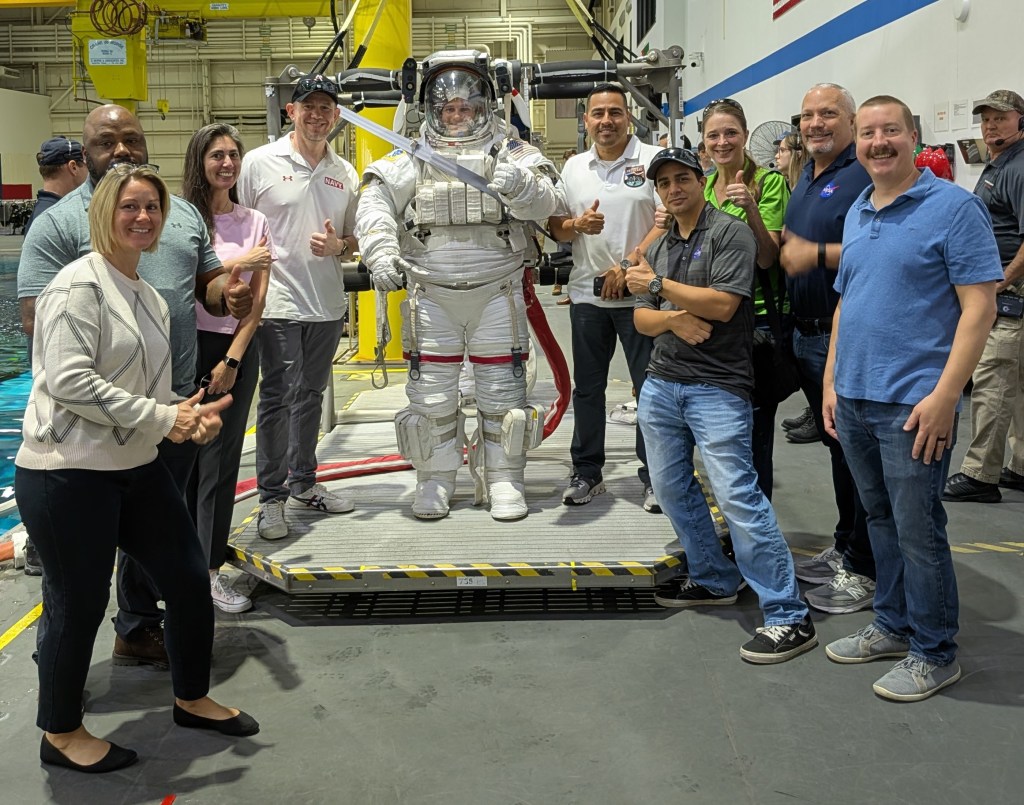
NASA Named one of America’s Best Employers for Veterans

Powerful New US-Indian Satellite Will Track Earth’s Changing Surface

What’s Up: November 2024 Skywatching Tips from NASA
- Search All NASA Missions
- A to Z List of Missions
- Upcoming Launches and Landings
- Spaceships and Rockets
- Communicating with Missions
- James Webb Space Telescope
- Hubble Space Telescope
- Why Go to Space
- Commercial Space
- Destinations
- Living in Space
- Explore Earth Science
- Earth, Our Planet
- Earth Science in Action
- Earth Multimedia
- Earth Science Researchers
- Pluto & Dwarf Planets
- Asteroids, Comets & Meteors
- The Kuiper Belt
- The Oort Cloud
- Skywatching
- The Search for Life in the Universe
- Black Holes
- The Big Bang
- Dark Energy & Dark Matter
- Earth Science
- Planetary Science
- Astrophysics & Space Science
- The Sun & Heliophysics
- Biological & Physical Sciences
- Lunar Science
- Citizen Science
- Astromaterials
- Aeronautics Research
- Human Space Travel Research
- Science in the Air
- NASA Aircraft
- Flight Innovation
- Supersonic Flight
- Air Traffic Solutions
- Green Aviation Tech
- Drones & You
- Technology Transfer & Spinoffs
- Space Travel Technology
- Technology Living in Space
- Manufacturing and Materials
- Science Instruments
- For Kids and Students
- For Educators
- For Colleges and Universities
- For Professionals
- Science for Everyone
- Requests for Exhibits, Artifacts, or Speakers
- STEM Engagement at NASA
- NASA's Impacts
- Centers and Facilities
- Directorates
- Organizations
- People of NASA
- Internships
- Our History
- Doing Business with NASA
- Get Involved
NASA en Español
- Aeronáutica
- Ciencias Terrestres
- Sistema Solar
- All NASA News
- Video Series on NASA+
- Newsletters
- Social Media
- Media Resources
- Upcoming Launches & Landings
- Virtual Guest Program
- Image of the Day
- Sounds and Ringtones
- Interactives
- STEM Multimedia

X-59 Fires Up its Engine for First Time on its Way to Takeoff

Hubble Captures a Galaxy with Many Lights

Still Kickin’ Since the ’70s: NASA’s Voyager Mission Keeps Exploring


NASA Shares Space Food Insight with Commercial Food Industry

Do You Have Proposals for New Human Research Studies Benefiting Spaceflight?

Hurricane Helene’s Gravity Waves Revealed by NASA’s AWE

NASA, Bhutan Conclude Five Years of Teamwork on STEM, Sustainability
Final venus flyby for nasa’s parker solar probe queues closest sun pass.

NASA’s New Edition of Graphic Novel Features Europa Clipper

NASA’s NEOWISE Spacecraft Re-Enters Atmosphere, But More Discoveries Await!

NASA’s Hubble, Webb Probe Surprisingly Smooth Disk Around Vega

Open Science Success Stories with Dr Keith Siew

Amendment 65: D.19 Habitable Worlds Observatory System Technology Demonstrations and Mission Architecture Studies Final Text and Due Date.

Math, Mentorship, Motherhood: Behind the Scenes with NASA Engineers

NASA Brings Drone and Space Rover to Air Show

Amendment 64: Significant Changes to Three Astrophysics ROSES Program Elements: D.3 APRA, D.7 SAT, and D.8 RTF

Power to Explore STEM Writing Challenge
Nasa knows – how can i get involved with nasa research.

40 Years Ago: STS-51A – “The Ace Repo Company”
El x-59 enciende su motor por primera vez rumbo al despegue, la nasa lleva un dron y un rover espacial a un espectáculo aéreo.

Destacado de la NASA: Felipe Valdez, un ingeniero inspirador
X-57 maxwell overview.

Converting Existing Aircraft
Modification i, tecnam data collection, modification ii, battery redesign and validation, electric retrofit and testing, modification iii, high-aspect ratio experimental wing, relocation of cruise motors, modification iv, 12 leading edge high-lift motors, environmentally friendly aviation, specifications.
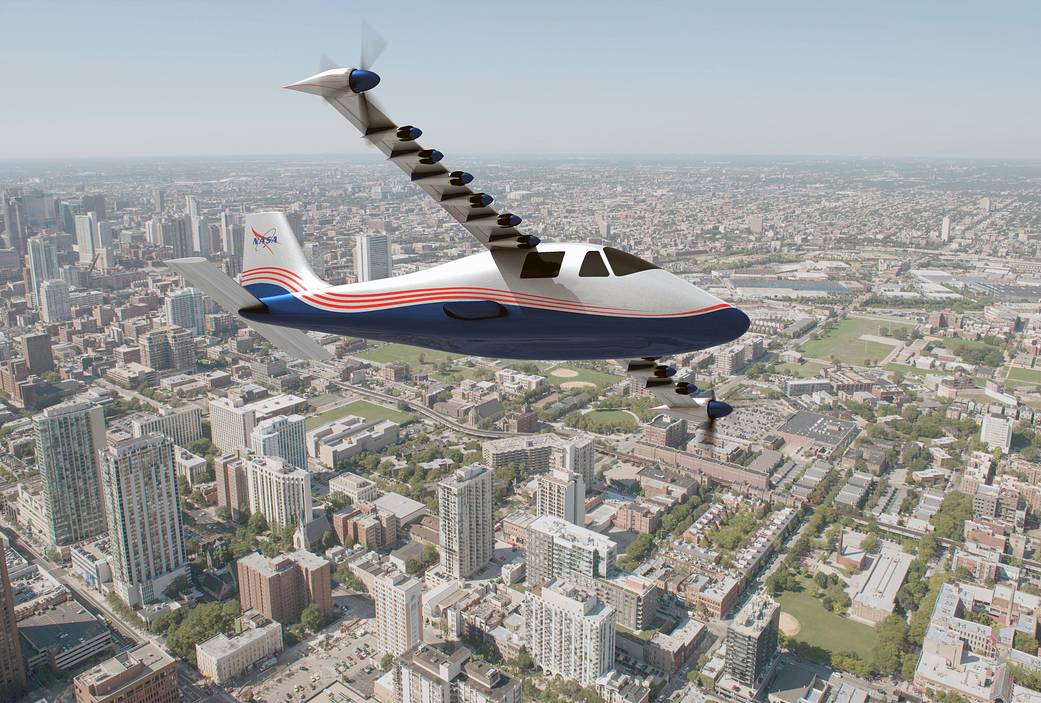
NASA’s X-57 “Maxwell” is the agency’s first all-electric experimental aircraft, or X-plane, and is NASA’s first crewed X-plane in two decades. The primary goal of the X-57 project is to share the aircraft’s electric-propulsion-focused design and airworthiness process with regulators, which will advance certification approaches for distributed electric propulsion in emerging electric aircraft markets.
The X-57 will undergo as many as three configurations as an electric aircraft, with the final configuration to feature 14 electric motors and propellers (12 high-lift motors along the leading edge of the wing and two large wingtip cruise motors).
The X-57 team is using a “design driver” as a technical challenge, to drive lessons learned, as well as best practices. This design driver includes a 500 percent increase in high-speed cruise efficiency, zero in-flight carbon emissions, and flight that is much quieter for the community on the ground.
The X-plane is being built by modifying a baseline Italian Tecnam P2006T to be powered by an electric propulsion system. The advantage of using an existing general aviation aircraft design is that data from the baseline model, powered by traditional combustion engines, can be compared to data produced by the same model powered by electric propulsion.
The project is being executed through four phases, referred to as “modifications”, of testing.
The X-57 Maxwell project includes four configurations and stages of research, called modifications.
The first phase of investigating the potential for electric propulsion included defining the requirements of the research, along with systems analysis, design, and a number of tests, both in the air and on the ground.
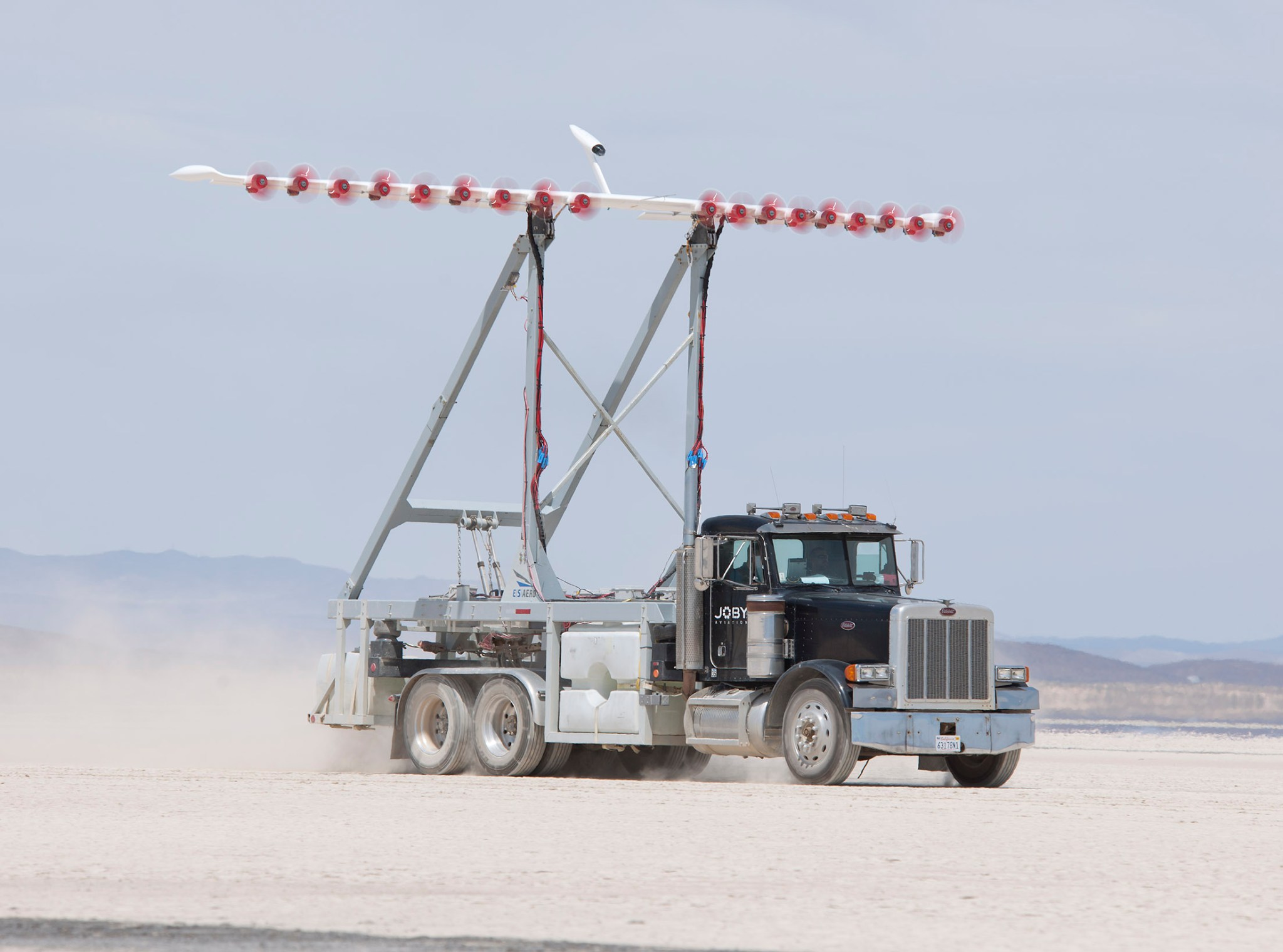
One of the earliest evaluations during the Modification I phase included ground validation of the distributed electric propulsion high-lift system, in 2015. The Leading Edge Asynchronous Propeller Technology testing, or LEAPTech, performed this validation on the Rogers Dry Lakebed at Edwards Air Force Base in California. The project was a collaboration between NASA and California companies Empirical Systems Aerospace of San Luis Obispo, and Joby Aviation of Santa Cruz.
An experimental electric wing, named the Hybrid Electric Integrated Systems Testbed, or HEIST, was hoisted atop a heavily modified big rig, which drove at speeds close to 80 mph to simulate the effects of a wind tunnel. The wing was outfitted with 18 electric motors and propellers, which ran simultaneously during the lakebed runs.
The tests showed that the motors produced a total of 300 horsepower. It validated that the airflow from the distributed 18 motors generated more than double the lift of the unblown wing.
In 2015, NASA pilots and engineers also performed test flights of a production-instrumented Tecnam P2006T in the skies above and around Edwards Air Force Base. The purpose of the flights was to collect data, such as lift, drag, cruise efficiency, energy usage and ride quality.
The X-57 is a P2006T integrated with an electric propulsion system, which will be flown to gather data from similar flights. The two sets of data will be analyzed and compared, helping NASA’s X-57 team to meet its design driver of validating the ability of distributed electric propulsion to improve efficiency.
The project’s second phase includes several milestones for X-57. In addition to continued systems testing and validation, Mod II marked the beginning of physical integration of X-57 itself into its earliest stage as an electric aircraft.
As an all-electric experimental aircraft, X-57 will be powered through the use of lithium ion battery systems. In order to implement these systems as safely as possible, NASA first had to validate that the batteries could safely power an entire flight profile, and demonstrate the system’s ability to isolate any rapid temperature increase to prevent it from spreading, and escalating into a fire – an event known as a “thermal runaway”.
NASA engineers achieved this milestone following a system redesign in 2017, allowing the batteries to be fabricated, and ensuring a safe environment for the test program. The successful battery redesign was shared publicly, providing an immediate benefit to the industry as a result of the research.
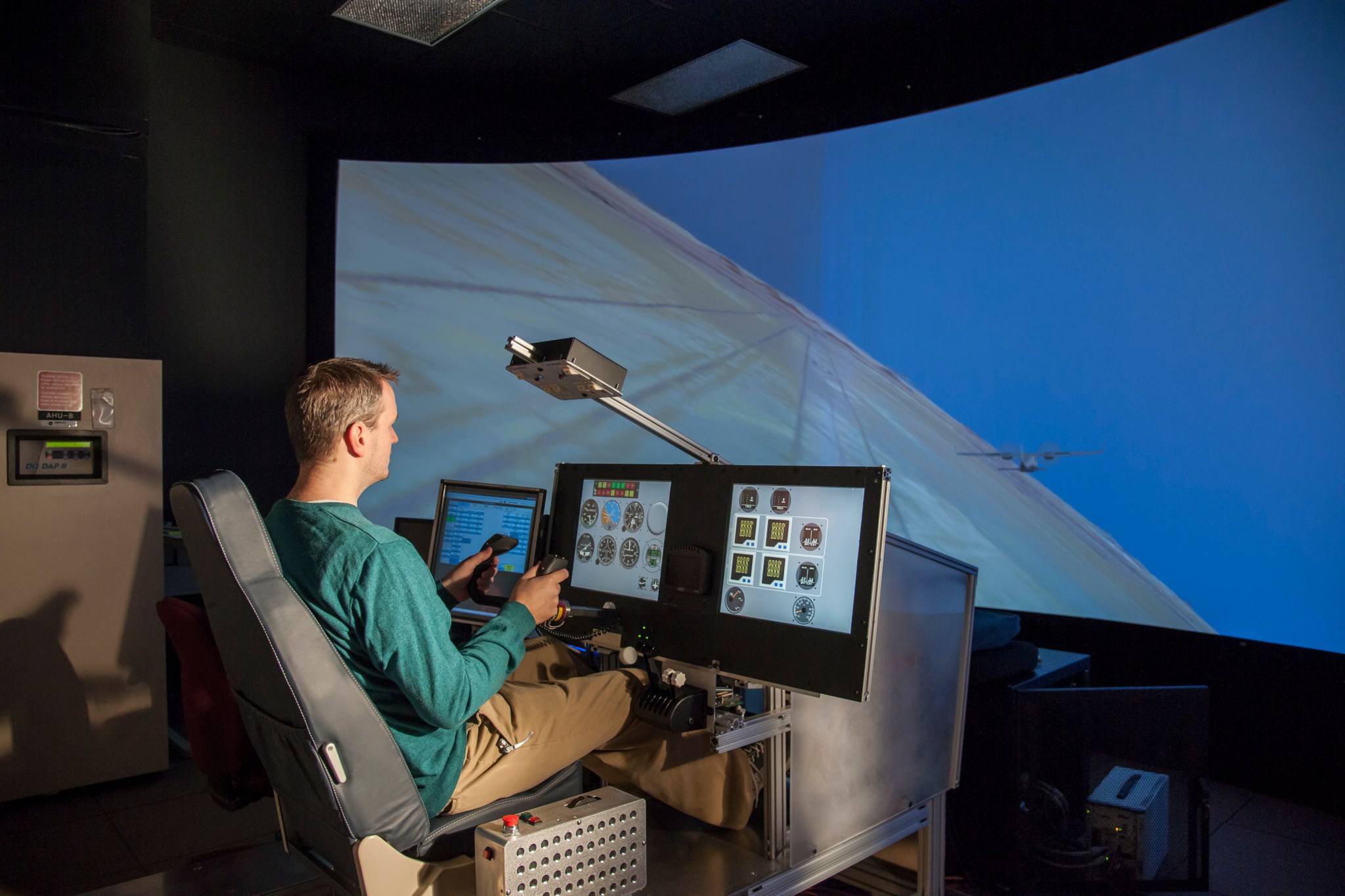
Pilots and engineers developed and began flying an X-57 simulator at NASA’s Armstrong Flight Research Center in California, designed to feature the specifications of the electric propulsion system. The interactive simulator began preparing pilots for X-57’s future flight-testing phase.
Flight control engineers and technicians at NASA Armstrong developed the simulator to provide a virtual flight experience based on what the X-plane itself will actually feel like when it’s in the air. The system helps familiarize pilots with the system and makes them more adept with reaction times and maneuvers.
Before an experimental electric system could be integrated into an aircraft, it had to first be tested and validated. A 13.5-foot tall test stand helped NASA researchers better understand the intricacies of electric motor systems, and provided validation for the thrust of the electric motors. In addition to helping engineers anticipate system integration challenges, the stand helped to verify the components of electric propulsion.
As early-stage technology is further evaluated, confidence in its use for future systems is established. Managing the differences between traditional aircraft propulsion and distributed electric propulsion is made easier by finding methods of managing those differences.
The Modification II version of the X-57 looks similar to the baseline 2006T, except the two traditional inboard combustion engines are replaced by two inboard electric motors, essentially turning the aircraft’s propulsion system electric.
Ground taxi tests at NASA Armstrong help to examine and validate the safety and functionality of the electric system, while flight tests will seek to validate the X-57’s electric motors, battery, and instrumentation.
Work on the third phase of the project began in tandem with Modification II, with the goal of taking the X-57 to a new level of experimental electric-powered flight.
Perhaps the most noticeable difference from the X-57’s Modification II configuration is the development and integration of an experimental, high-aspect ratio wing . Designed by Xperimental of San Luis Obispo, California, the wing features a large reduction in area, with wing loading increasing from 17 pounds per square foot to 45 pounds per square foot.
The reduction in wing area also contributes to more efficient cruise flight through decreasing friction drag. The final Modification IV effort will demonstrate that the high aspect ratio wing with the integrated high lift motor system will allow the X-57 to take off and land at the same speed as the baseline P2006T. The aircraft will also be less sensitive to gusts and turbulence, leading to a smoother flight.
One of the most critical, and noticeable, elements of the high aspect ratio wing is the relocation of the large cruise motors to the wing tips. The replacement of 100-horsepower Rotax 912S engines with 60-kilowatt motors, developed by Joby Aviation, reduce the weight of each motor and propeller from approximately 125 pounds to about 57 pounds.
The much lighter-weight electric motors allow for their relocation outboard. By moving the cruise motors from their Mod II inboard position to the wingtips for Mod III, the cruise motors recover energy that would otherwise be lost in the wingtip vortices.
Nacelles, which are outer casings that can generally act as housing for an aircraft’s engine, are also installed along the leading edge of the wing where 12 high-lift motors will eventually be positioned.
The final configuration of the X-57 presents the X-plane in its full, experimental configuration.
The X-57, in its final form of the project, features 12 high-lift motors along the leading edge of the distributed electric propulsion wing. Similar to the 18 small motors used during LEAPTech ground tests, the high-lift motors are electrically powered to generate enough lift for X-57 to be able to take off at standard Tecnam P2006T speeds, even with the high aspect ratio experimental wing.
The high-lift motors and propellers are designed to activate, along with the wingtip cruise motors, to get the X-plane airborne. When the plane levels out for cruise mode, the high-lift motors will then deactivate, and the five propeller blades for each motor will then stop rotating, and will fold into the nacelles, so that they don’t create unwanted drag during cruise. The two wingtip cruise motors will maintain flight during this phase of the flight.
When the time comes to land, the motors will then reactivate, and centrifugal force will cause the propeller blades to unfold and create the appropriate lift for approach and landing.
The design driver for X-57 will also seek to reach the goal of zero carbon emissions in flight, which would surpass the 2035 N+3 efficiency goals. Electric propulsion provides not only a five-to-ten times reduction in greenhouse gas emissions, but it also provides a technology path for aircraft to eliminate 100 Low Lead AvGas, which is the leading contributor to current lead environmental emissions.
Additionally, since the X-57 will be battery-powered, it can run off renewable based electricity, making clear the environmental and economic advantages.
(Based on Mod IV configuration)
Goal: Help develop certification standards for emerging electric aircraft markets.
Design Driver: 500% increase in high-speed cruise efficiency, zero in-flight carbon emissions, and flight that is much quieter for the community on the ground.
Objectives are to:
- Mod II: Demonstrate 3.3-times lower energy use at high speed compared to original P2006T.
- Mod III: Demonstrate 1.5-times lower energy use at high speed compared to Mod II.
Aircraft Weight: Approximately 3,000 pounds.
Maximum Operational Altitude: 14,000 feet.
Cruise Speed: 172 mph (at 8,000 feet)
Critical Takeoff Speed: 58 knots (67 mph).
- Lithium Ion.
- 860 pounds.
- 69.1 kilowatt hours (47 kilowatt hours usable)
Cruise Motors and Propellers (2):
- 60 kilowatts.
- Air-cooled.
- 5-foot diameter propeller.
- Out-runner, 14-inch diameter.
- 117 pounds each, combined weight.
High-Lift Motors and Propellers (12):
- 5-blade, folding propeller.
- 10.5 kilowatts.
- 1.9 foot diameter propeller.
- 15 pounds each, combined weight.
Related Terms
- Armstrong Flight Research Center
- Aeronautics Research Mission Directorate
- Integrated Aviation Systems Program
- X-57 Maxwell
Discover More About Armstrong
Armstrong Capabilities & Facilities
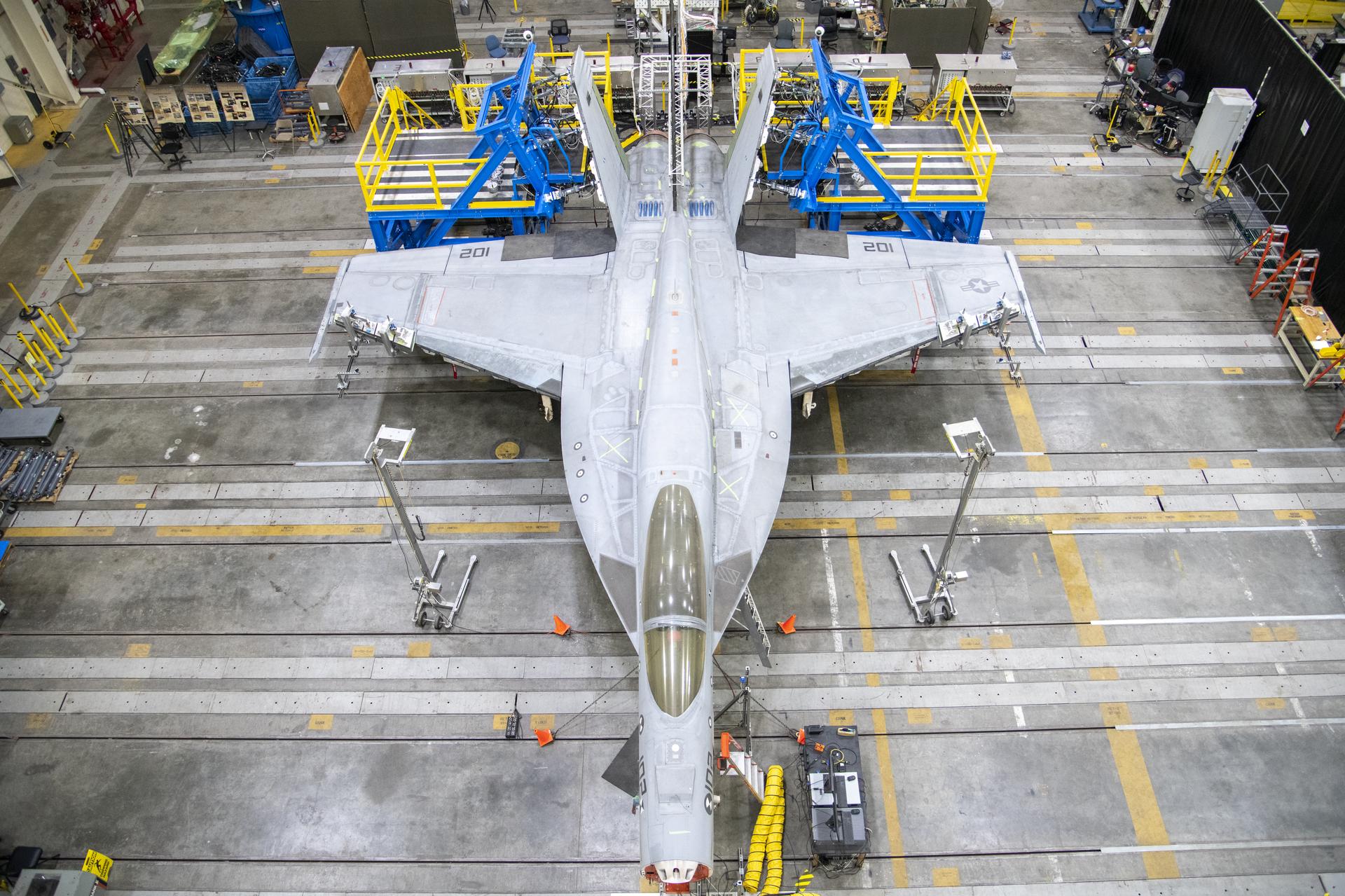
Armstrong Aeronautics Projects
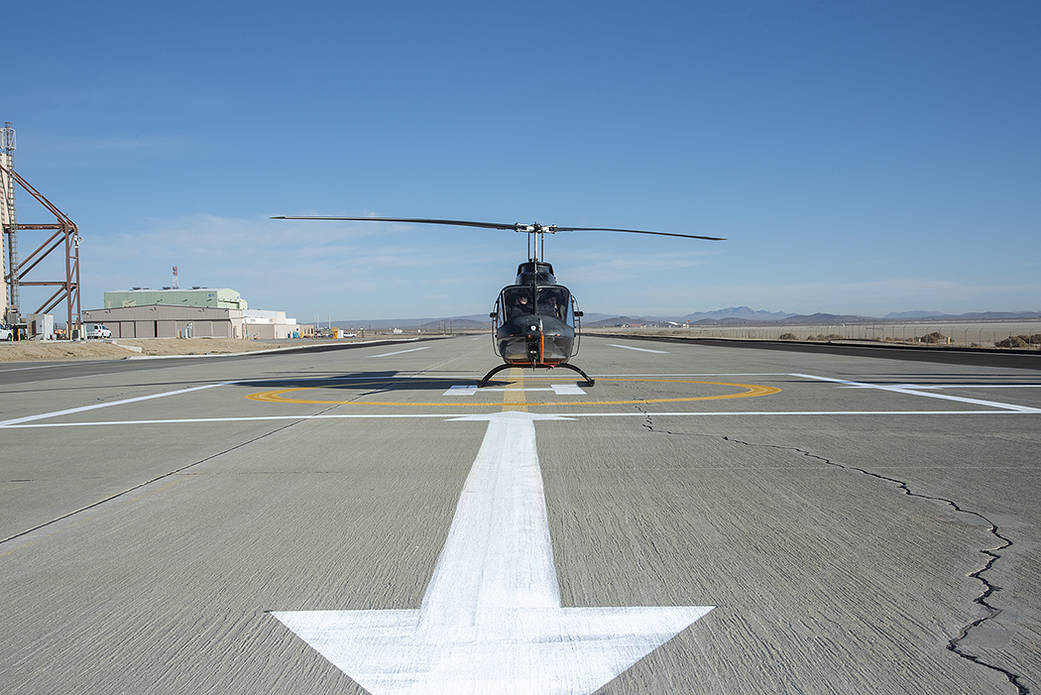
Armstrong Science Projects
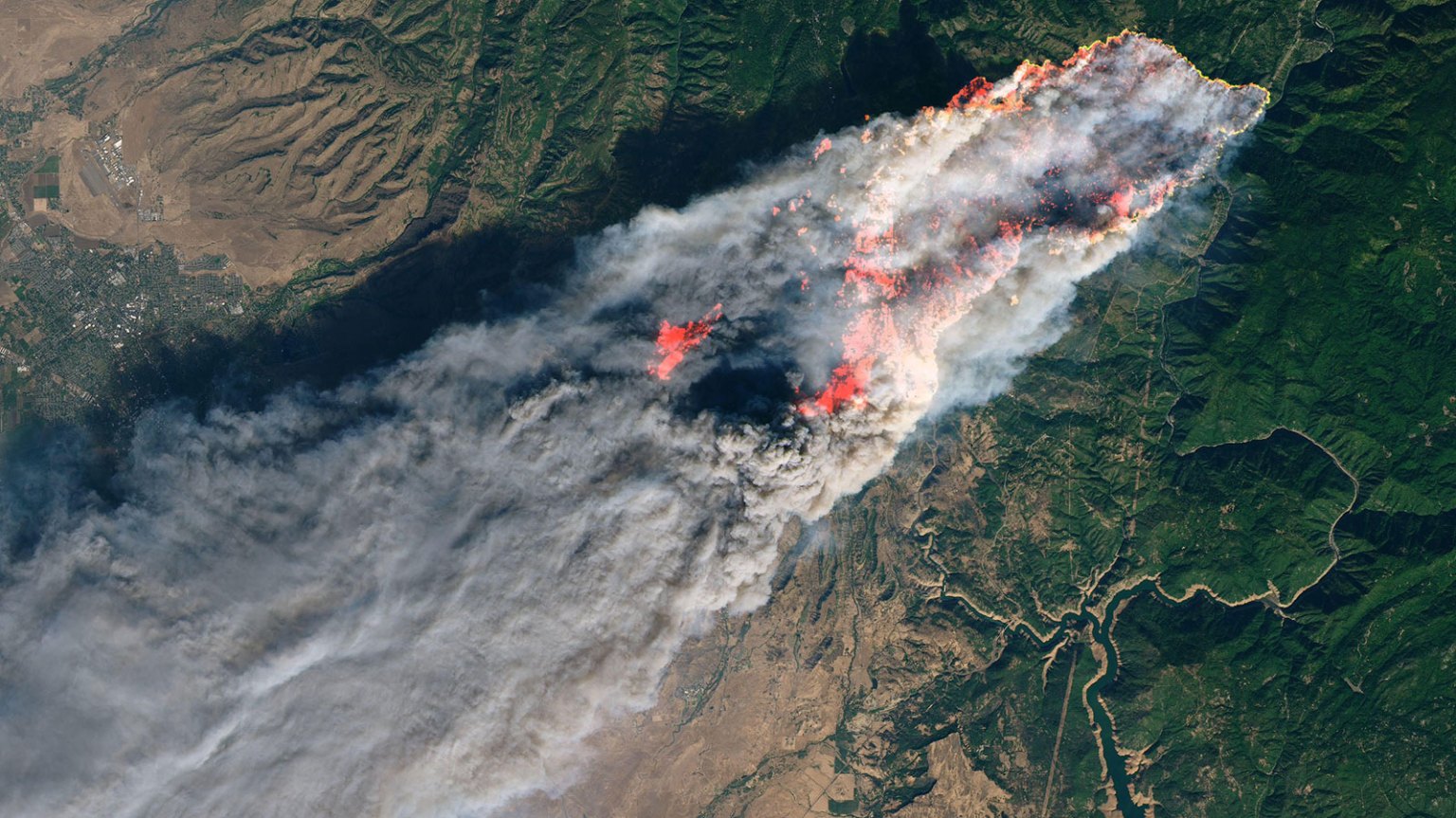
Armstrong Space Projects
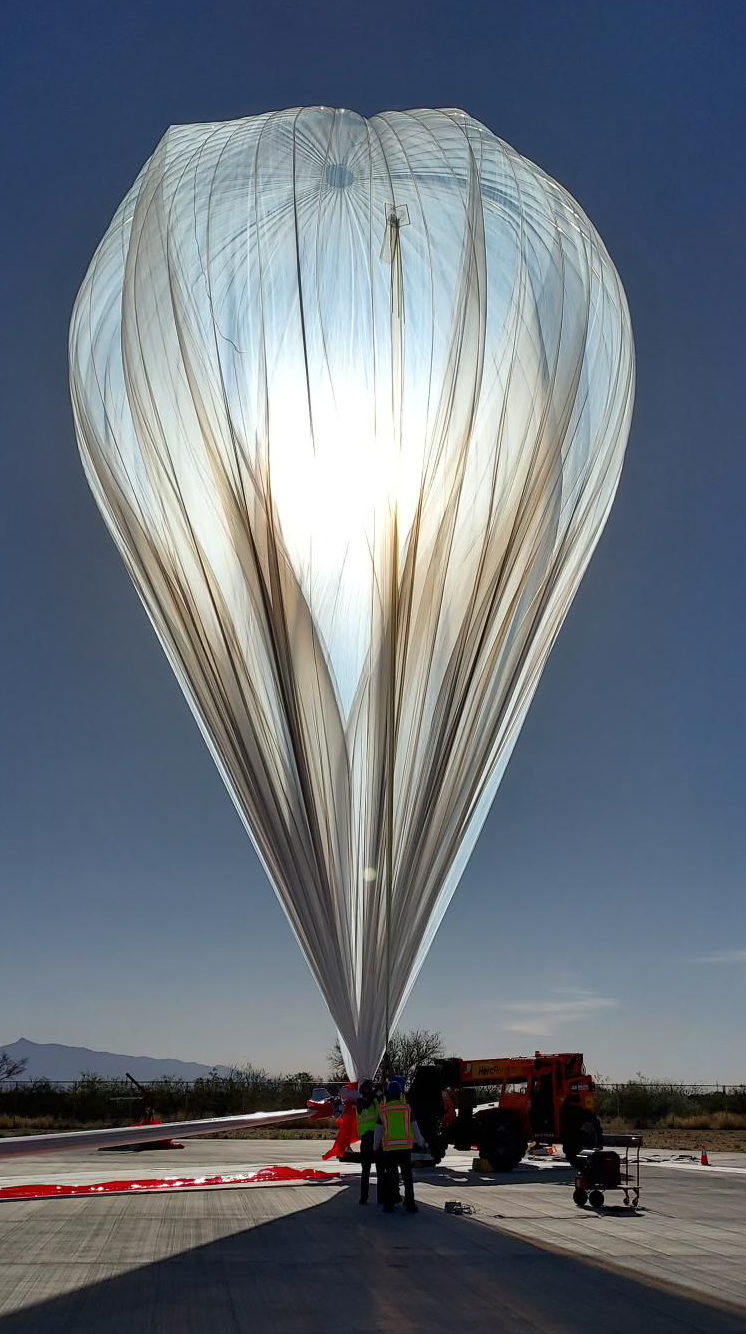

NASA’s X-59 Quiet Supersonic Aircraft Fires Up Engine For The First Time Ahead Of First Flight
X-59’s engine started for testing for the first time.
NASA’s Quesst (“Quiet SuperSonic Technology”) mission recently achieved a key milestone as it began testing the engine that will power the X-59, an experimental supersonic aircraft developed by Skunk Works for NASA’s Low-Boom Flight Demonstrator project.
The first engine tests, which were carried out on Oct. 30, 2024 at Lockheed Martin’s Skunk Works facilities in Palmdale, allow the X-59 team to validate that all aircraft systems work together under the power of the one-of-a-kind aircraft’s engine, as opposed to previous tests that relied on external power sources. These engine tests are a crucial step towards preparing the X-59 for its maiden flight.
According to NASA, the testing is being done in stages, with the first phase involving low-speed engine rotation without ignition to check for leaks and ensure that all systems are communicating properly. After verifying these systems, the team fueled the aircraft and began low-power engine tests to ensure smooth operation without issues or leaks.
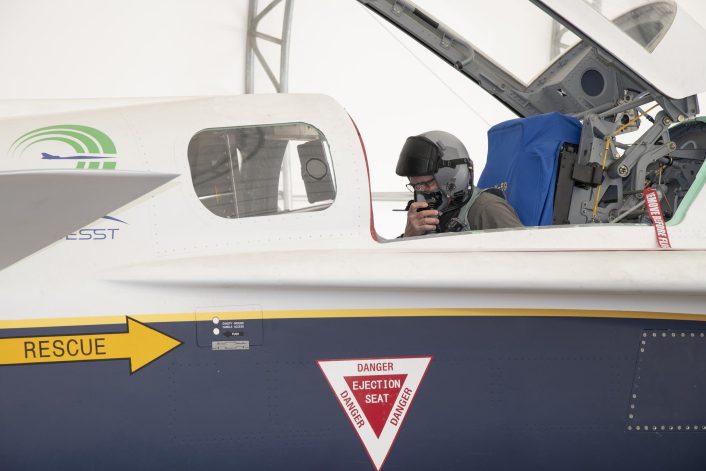
Jay Brandon, NASA’s X-59 chief engineer, explained:
This first phase of engine testing was a warmup to confirm everything looked good before running the engine. We then conducted the initial engine start, which took the engine out of preservation mode since its installation. This first start was an opportunity to ensure the engine and related systems—like hydraulics, electrical, and environmental controls—were all working as expected.
Supersonic air travel disappeared with the end of the former-Soviet Tupolev Tu-144 supersonic transport and the famous joint French and English Concorde SST built by Aérospatiale/BAC. The Soviets had little success with their SST program, which predated the first Concorde flight by three months but only remained operational from 1975 until 1978. The Anglo-French Concorde was significantly more successful, flying commercially from 1976 until 2003 when it was retired after a tragic crash on July 25, 2000, at Charles de Gaulle Airport in Paris, France. At the time, neither program achieved a high degree of economic efficiency and both suffered from the constraints of traditional supersonic flight.
New low-boom technology, that works by using an elongated fuselage that (more or less) mutes the sonic boom, should make the X-59 able to fly at 1.4 times the speed of sound, or 925 mph, at 55,000 feet generating a quieter sonic thump than the undesirable and potentially damaging “traditional” loud sonic booms , that are prohibited for commercial flights during overland flight.
For 50 years, the U.S. and other nations have prohibited such flights because of the disturbance caused by loud, startling sonic booms on the communities below. The X-59, is an experimental aircraft 99.7 feet long and 29.5 feet wide flown by a single pilot, designed to generate a quieter sonic boom which should be within acceptable noise levels to help the FAA to lift the ban on commercial supersonic travel over land imposed in 1973: according to NASA, the sonic boom generated by the new aircraft will be less than 75 perceived dB on the ground, about a third less than the Concorde, which was reported around 100-110 dB.
New low-boom technology, using an extended fuselage to soften the sonic boom aims to produce a gentler “sonic thump” rather than the loud booms that led to bans on supersonic flights over land.
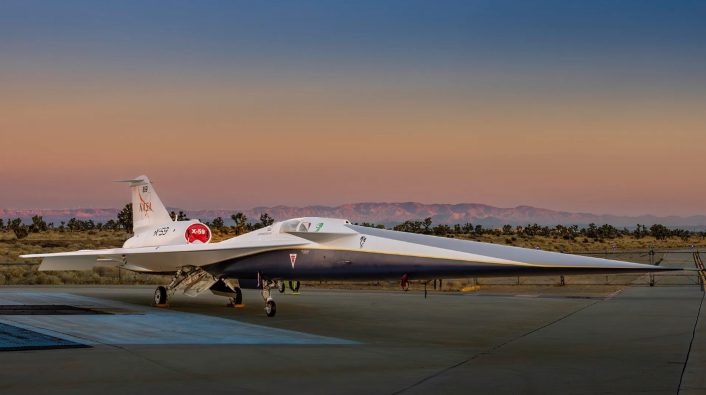
Powered by a modified F414-GE-100 engine with 22,000 pounds of thrust, the X-59 is expected to reach Mach 1.4, or 925 mph, at 55,000 feet. The engine’s unusual placement on top of the aircraft helps reduce noise.
More from The Aviationist
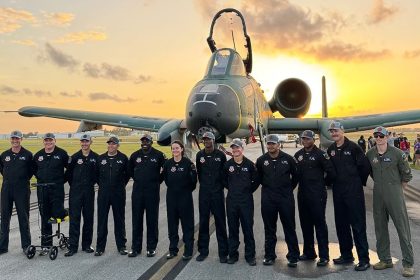
A-10C Demonstration Team Flies Final Show
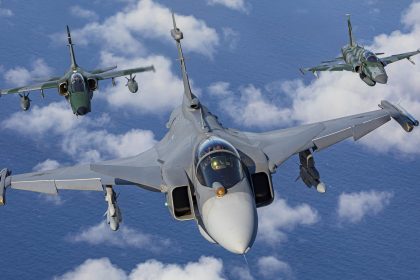
Colombia Reportedly Considering Saab Gripen to Replace its Kfirs as Swedish Jet Debuts in Multinational Drill in Brazil
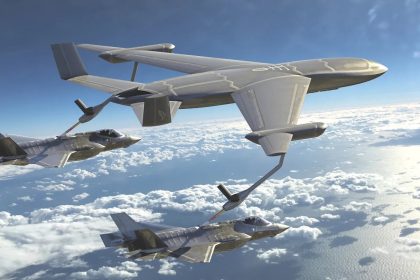
Skunk Works Reveal New Stealthy Tanker Concept With Twin Flying Booms
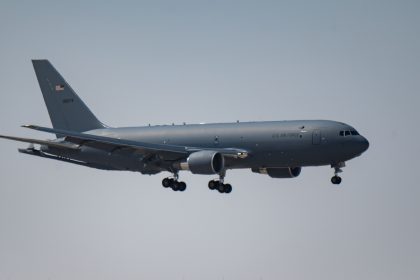
U.S. Air Force Establishes First KC-46A Pegasus Expeditionary Air Refueling Squadron
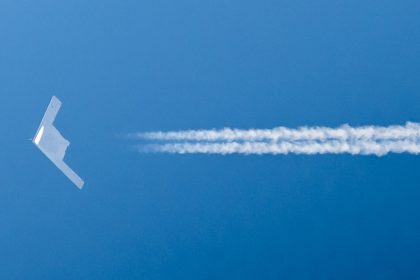
Take A Look At These New Photographs Of The B-21 Raider During A Test Flight
The pilot will fly the aircraft using a unique cockpit design without a conventional forward-facing window. Instead, a central 4K monitor acts as the “window,” giving the pilot a clear view of surrounding air traffic and offering visual guidance for approaches, landings, and takeoffs. This monitor, a key component of the aircraft’s eXternal Visibility System (XVS), shows stitched-together images from two external cameras combined with terrain data from an advanced computer system. While the cockpit includes real windows on the sides and a traditional canopy to help the pilot maintain a view of the horizon, displays below the XVS screen provide essential information on aircraft systems and trajectory to ensure safe flight.
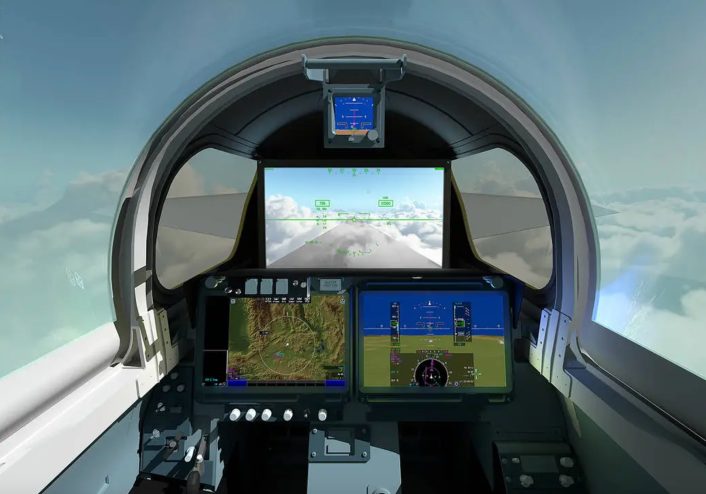
In May this year, an independent Flight Readiness Review board, consisting of experts from various parts of NASA, completed aasessing the X-59 project team’s safety protocols for protecting both the public and staff during ground and flight tests. This review involved a thorough examination of the team’s analysis of potential risks, with particular attention to safety measures and risk assessment.
The Flight Readiness Review was a crucial step in the initial phase of securing flight approval.
The more recent engine tests are part of a broader series of ground checks essential for ensuring safe and effective flight. With these significant testing milestones in progress, the first flight is anticipated in early 2025. The team will continue through critical ground tests, solving any technical issues that may arise with this unique aircraft, aiming to pinpoint a specific date for the first flight as testing progresses.
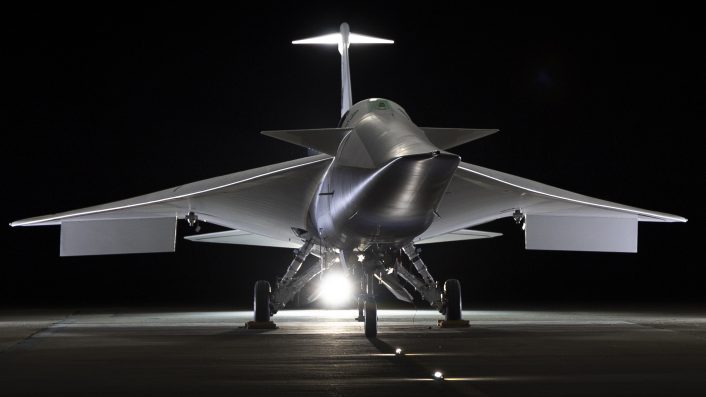
Testing is taking place at Lockheed Martin’s Skunk Works facility in Palmdale, California. In later phases, the team will test the engine at higher power levels with quick throttle changes and replicate real flight conditions.
The success of these tests represents the culmination of eight years of my career. This is just the start of our journey. It’s like hearing the first note of a symphony—years of teamwork are now being tested, and we’re eager to see the project come together as we progress toward flight. Paul Dees, NASA’s deputy propulsion lead for the X-59.
Following engine tests, the X-59 team will conduct aluminum bird tests, providing data on both regular and simulated failure conditions. They’ll then conduct taxi tests, moving the aircraft on the ground, and complete final steps leading up to its maiden flight.
After the first flight, the aircraft will conduct its first quiet supersonic flight then the Quesst team will conduct several of the aircraft’s flight tests at Skunk Works before transferring it to NASA’s Armstrong Flight Research Center in Edwards, California, which will serve as its base of operations. After the successful completion of the flight tests, NASA plans to fly the X-59 aircraft over several cities across the U.S. to collect data about the sound generated by the experimental airplane and how people perceive it from the ground. NASA will provide that data to the Federal Aviation Administration and international regulators.
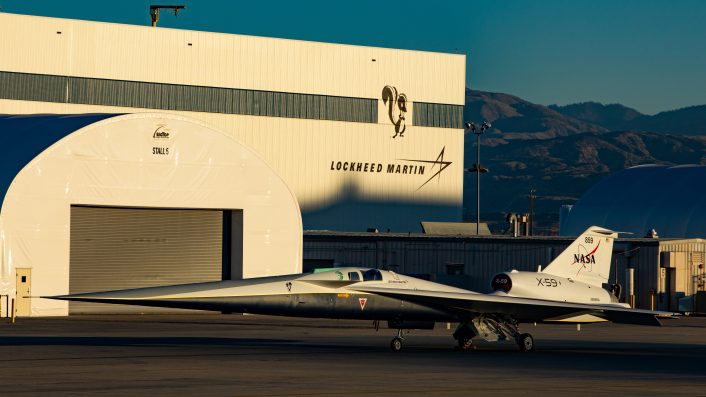
Stay Connected
Latest news.

Live Model of China’s CH-7 Flying Wing Stealth UCAV Revealed

MiG-29, MiG-21, and Two F-22s Carry Out Memorial Flyover For Col. (Ret.) Gail Peck At Nellis AFB

A Breakdown of the PLA Navy’s Catapult-Launched J-15T Unveiled ahead of Zhuhai Air Show

Royal Navy Proves Martlet Air-to-Air Capability in New Live-Fire Exercise
Work with us.

Sign in to your account
Remember me

IMAGES
COMMENTS
Airplane authors (or even the user) can permanently make an aircraft to ALWAYS use the experimental flight model by setting the option in planemaker. Simply open the plane in planemaker, choose the "Author" option and then click the "Always use Experimental flight model" option. If you don´t do this you would have to set the option in X-Plane ...
On 12/24/2022 at 10:44 PM, Janov said: Hi Neville, the term "experimental flight model" is from the X-Plane 11 era, where two different flight models were options. In X-Plane 12, there is only one flight model, you can´t choose. Ask the Skylab team if their product is compatible with X-Plane 12. If it is not, do not use it in X-Plane 12.
Basically 11.40 has "the experimental flight model rev 2" - it's been further modified to be more accurate. We did not give authors the option to _require_ the experimental FM because it is _still changing_. Imagine if aircraft authors had had this option in 11.30. All of the new changes in 11.40 would have screwed up their aircraft.
X-Plane 12 Digital Download. $ 79.99. Attention to detail and realism is a priority at Laminar Research. In X-Plane 11.30 we're striking a balance between cutting edge flight model changes and stability with a new experimental flight model option in General Settings. The "use experimental flight model" checkbox allows developers and users ...
X-Plane 12 Flight Model Update - Supersonic Transition, Delta Wings and Mass Properties. Posted February 22, 2022. ... and found a better way to curve-fit the experimental data. As well, I looked at the induced drag reduction with ground effect, and since induced drag is tied to downwash (one is the cause of the other) blending the downwash ...
The Experimental Flight Model (EFM) is currently supported in the following airplanes: All the other REPs will show a warning message if the EFM is enabled. Since X-Plane 11.50, it is possible for a developer to always "force" the EFM on for his airplane regardless of the user's choice in X-Plane settings.
X-Plane 11.40 Release Notes. X-Plane 11.40 is a major update with changes to the experimental flight model, including seaplane handling, stalling, and prop wash improvements. Known bugs. XPD-7871 Dark contrails instead of white. XPD-9388 Software hangs upon exit when using VR. XPD-9501, XPD-9449 AMD driver bugs with displays & weapons.
As you know, the Experimental Flight Model (EFM) has been around for a while since X-Plane 11.40 and it will be the only flight model available in X-Plane 12. Until REP v4.5 only a few planes supported the EFM, the C172SP being among the firsts. Starting from version 4.6, REP on X-Plane 11.40+ will always enable the EFM on all the planes.
The experimental flight model has proven to be quite stable since it was released in X-Plane 11.40, so authors can now set up their aircraft to use it by default. The new check box is found in the Author screen in Plane Maker. When it is checked, the aircraft will always get the 11.40 experimental flight model, no matter what the user pref for ...
You can fly without the experimental flight model, but downsides is less accurate performance parameters and lacking of some features unique to the "experimental" flight model, like refined downwash calculations. If you are a layman just droning around for fun, chances are you won´t even notice the difference. Cheers, Jan
A: The experimental flight model is already considered stable and reliable by the X-plane developer. The improvements it brings enables much better realism and accuracy. The current experimental flight model will become the standard model in a future version of X-plane (Some version after 11.50). Q: Can I use the 'normal' flight model instead?
Posted July 3, 2020. Flight model is reviewed for version 1.50 after the upcoming update 1.20. For now, the jet is NOT fully ready for the experimental flight model. With version 1.20 it will be fully ready for Vulkan / Metal. We use quite a few workarounds and plugin calculations to get accurate flight model results.
The new "experimental flight model" may indeed be better, it certainly looks like it from the videos I have seen where Austin explains it's features. That does not change the fact that if a developer builds an aircraft for the older flight model and painstakingly adjusts it to fly correctly on that flight model, the experimental flight model ...
Posted November 14, 2020. There is a different trim setting during takeoff, so setting the "correct" trim will lead to higher-than usual yoke forces needed (due to different downwash model) and the drag is different (due to the different lift/drag of the fuselage during high AOA flight). Both of these things are not super obvious, but you will ...
Hey people, is anyone using the LU737 with experimental flight model enabled? I am and I noticed that the plane is more reactive kinda like the Zibo (still needs n1 to be at 50% in order to move when taxiing though). ... It can encompass anything of interest to the PPG community, including paramotors, paragliding, wings, gear, ultralight flying ...
the new laminar experimental flight model is beta and under evolution. Any aircraft that was not extensively tested, recalibrated and fine tuned by its developer to perform under the experimental flight model -and the developer didn't say explicit to enable experimental flight model-will work, but will not perform any close to the manufacturer performance parameters and flying behavior because ...
As of X-Plane 11.50 and version 1.8 of our planes, each plane will automatically use the experimental flight model, regardless of the setting selected by the user in X-Plane's General settings window. v1.8 of the planes have been tuned and adjusted to fly correctly in the new experimental flight model. So no action is required by you, the user.
NASA's X-57 "Maxwell" is the agency's first all-electric experimental aircraft, or X-plane, and is NASA's first crewed X-plane in two decades. The primary goal of the X-57 project is to share the aircraft's electric-propulsion-focused design and airworthiness process with regulators, which will advance certification approaches for ...
After the successful completion of the flight tests, NASA plans to fly the X-59 aircraft over several cities across the U.S. to collect data about the sound generated by the experimental airplane ...
If I interpret it correctly he says that his own tweak code of the aerodynamics (esp. with respect to the fuselage) are necessary to make the Zibo B738 fly as nicely as it does. If he used the LR experimental mode he wouldn't be able to tweak the model for the 737 fuselage as it is too fixed.
A couple I can think of are my Hughes 500D & the Thranda PC-6 Porter. That won't happen in the lifetime of X-Plane 11. The non-experimental flight model will be available for all of X-Plane 11, and with the next version, the latest of the experimental will be frozen as the new "stable" of that generation, to stay as long that generation exists ...